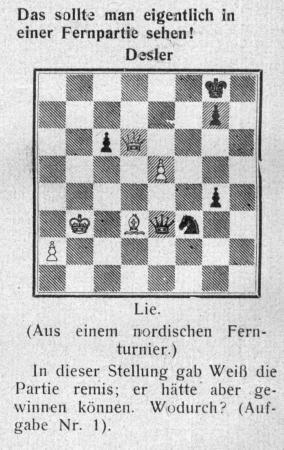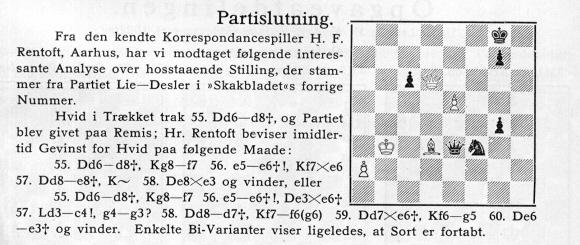Chess Notes
Edward Winter
When contacting us by e-mail, correspondents are asked to include their name and full postal address and, when providing information, to quote exact book and magazine sources. The word ‘chess’ needs to appear in the subject-line or in the message itself.
| First column | << previous | Archives [108] | next >> | Current column |
8113. Tintin by Hergé
Dominique Thimognier (Fondettes, France) submits the front cover of Le Petit Vingtième, 2 July 1936, featuring General Alcazar and Tintin in L’oreille cassée (The Broken Ear):
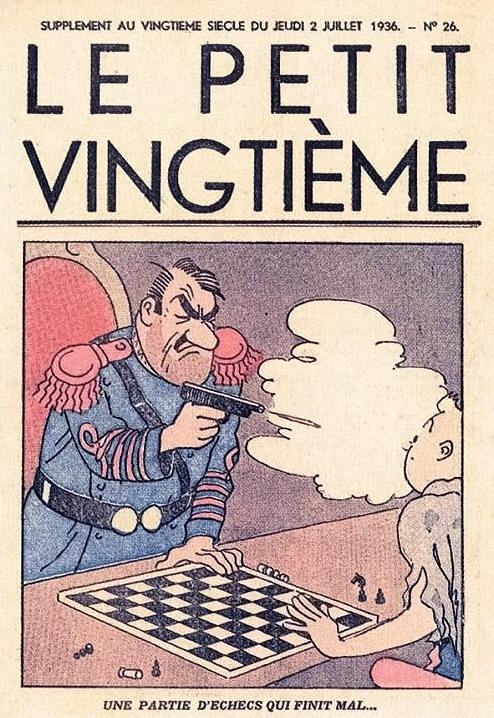
8114. Emil Kemeny
The series of scholarly monographs from McFarland & Company, Inc. continues with Emil Kemeny A Life in Chess by John S. Hilbert.

Pages 228-229 have an exhibition game, new to us, which may be of theoretical interest today:
Emil Kemeny – Harry Nelson Pillsbury
Franklin Chess Club, Philadelphia, October 1899
Ruy López
1 e4 e5 2 Nf3 Nc6 3 Bb5 Nf6 4 O-O Nxe4 5 d4 Nd6 6 Bxc6 dxc6 7 dxe5 Nf5 8 Qxd8+ Kxd8 9 Nbd2 h6 10 b3 Be6 11 Bb2 Be7 12 Ne4 b6 13 c4 Kc8 14 h3 g5
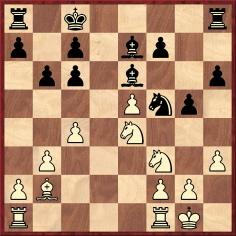
15 Nd6+ Bxd6 16 exd6 Rg8 17 dxc7 Kxc7 18 g4 Ne7 19 Nd4 Bd7 20 f4 gxf4 21 Rxf4 f5 22 Re1 Ng6 23 Rff1 fxg4 24 Ne6+ Kc8 25 hxg4 Nh4 26 Kh2 Rxg4 27 Rf8+ Kb7 28 Rf7
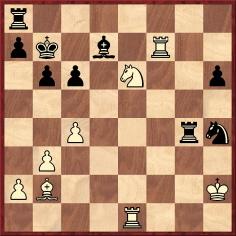
28...Rag8 29 Rxd7+ Kc8 30 Rd3 Rg2+ 31 Kh3 Rxb2 32 Kxh4 Rxa2 33 Nf4 Rh2+ 34 Nh3 Rd8 35 Ree3 Rxd3 36 Rxd3 a5 37 Kg3 Rc2 38 Nf4 a4 39 bxa4 Rxc4 40 Ra3 Kb7 41 Ne6 Ka6 42 Nd8 Ka5 43 Rb3 b5 Drawn.
The book includes Kemeny’s annotations from the Philadelphia Public Ledger, 25 October 1899.
8115. Monte Carlo, 1903
Emil Kemeny was self-effacing, and his profile was kept low by Edition Olms Zürich in 1983 when it reprinted his volume on Monte Carlo, 1903. As John Hilbert points out on page 280 of Emil Kemeny A Life in Chess, the reprint’s dust-jacket, title page and Foreword (by Christiaan M. Bijl) made no mention of Kemeny, even though he was the book’s publisher, editor, annotator and original distributor.
8116. Alekhine games
Chess researchers soon learn that their work, however painstaking, is liable to be either plagiarized or, conversely, ignored. A familiar Alekhine brilliancy illustrates the latter course:
1 e4 c5 2 Nf3 e6 3 d4 b6 4 d5 d6 5 Nc3 a6 6 a4 Nf6 7 Bd3 h6 8 O-O Be7 9 h3 O-O 10 Re1 exd5 11 Nxd5 Nbd7 12 Bf4 Nxd5 13 exd5 Nf6 14 c4 Re8 15 Bc2 Nh7 16 Qd2 Bd7 17 Bxh6 gxh6 18 Qxh6 f5
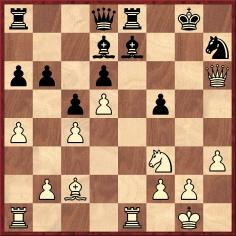
19 Re6 Bxe6 20 Qxe6+ Kg7 21 Qxf5 Nf8 22 Qg4+ Kh6 23 Ra3 Bf6 24 h4 Ra7 25 Ng5 Re1+ 26 Kh2 Qe8 27 Rf3 Qe5+ 28 g3 Qxb2 29 Rf5 Ng6
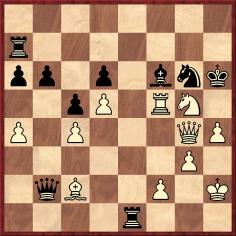
30 Qh5+ Resigns.
When the game was published on page 267 of the June 1934 BCM (‘played in a simultaneous display in Czechoslovakia last year’) Black was named as ‘Ing. Kontay’, and no other details were provided (C.N. 1041). However, pages 479-480 of Alexander Alekhine’s Chess Games, 1902-1946 by L. Skinner and R. Verhoeven (Jefferson, 1998) showed that the exhibition took place in Prague on 20 November 1933 and that Black’s name was Koutný. The source specified was Československý Šach (January 1934, pages 11-12):

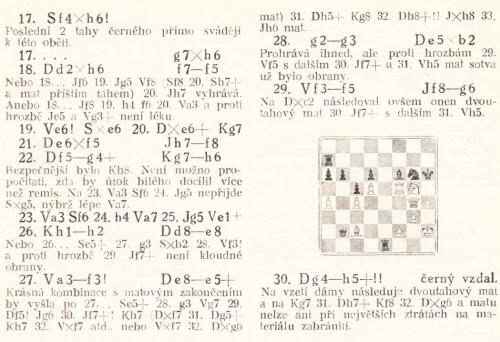
Thus apart from the unrecorded forename of Black (‘Ing.’ means engineer, i.e. inženýr), all key details concerning the game were readily available in 1998.
Readers who recall C.N. 3507 will not be surprised to learn that page 5 of Alexander Alekhine Master of Attack by A. Raetsky and M. Chetverik (London, 2004) went astray, dating the game not 1933 but ‘1935’. A date one further year out (‘1936’) was on page 75 of another Everyman Chess book, The Times Winning Moves by R. Keene and B. Jacobs (London, 2003):
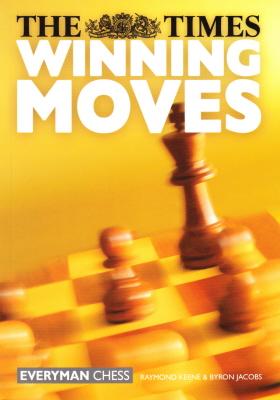
The inaccurate or incomplete references to other Alekhine games in The Times Winning Moves (see pages 29, 33, 35 and 41) could all have been avoided by consulting Alexander Alekhine’s Chess Games, 1902-1946. Below is the last of those four positions, offering a small example of how chess information and knowledge go backwards in the hands of hack writers:
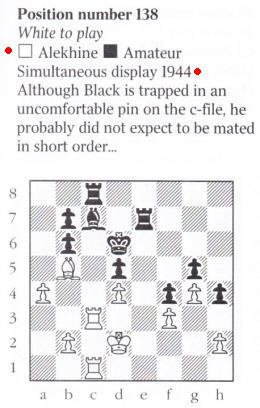
Keene and Jacobs, 2003.
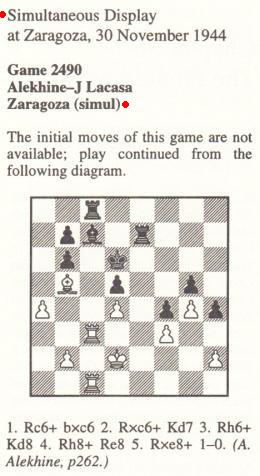
Skinner and Verhoeven, 1998
When this game ending was given in the Spanish and English editions of Pablo Morán’s monograph on Alekhine (see pages 337-338 and 262 respectively), it was pointed out that Black was a well-known figure, Juan Lacasa Lacasa.
A more general point is that many of the other positions
in the 2003 Keene/Jacobs book published by Everyman Chess
were mere repeats of what had already appeared in two
similar volumes by Raymond Keene for Batsford, The
Times Winning Moves (1991) and The Times Winning
Moves 2 (1996). For instance, ‘Yanowsky v Toriran,
Canada, 1953’ is in the second and third books (on,
respectively, pages 78 and 57).
8117. Lasker v Sandberg
From page A3 of the Brooklyn Daily Eagle, 12 June 1924 (column by Hermann Helms):
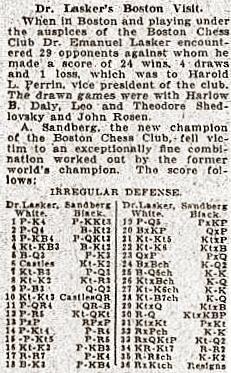
Emanuel Lasker – A. Sandberg
Boston, 24 May 1924
King’s Fianchetto Defence
1 e4 g6 2 d4 Bg7 3 f4 b6 4 Nf3 Bb7 5 Bd3 e6 6 O-O Ne7 7 Nc3 d6 8 Ne2 Na6 9 c3 Qd7 10 Ng3 O-O-O 11 a4 Rdf8 12 a5 Nb8 13 axb6 axb6 14 b4 h5 15 b5 h4 16 Ne2 f6 17 Ra7 e5 18 Be3 f5
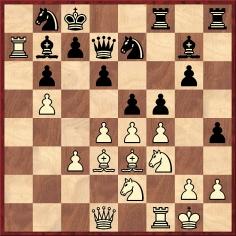
19 d5 fxe4 20 Bxe4 Qxb5 21 Ng5 Nxd5 22 Ne6 Nxe3
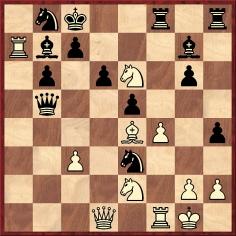
23 Qxd6 cxd6 24 Bxb7+ Kd7 25 Bd5+ Ke8 26 Nxg7+ Kd8 27 Ne6+ Ke8 28 Nc7+ Kd8 29 Nxb5 Nxd5 30 Rd1 Nxf4 31 Nxf4 exf4 32 Rxd6+ Ke8 33 Rxb6 Nd7 34 Rbb7 Rh7 35 Ra8+ Ke7 36 Rxd7+ Resigns.
It is difficult to understand why this game (although with 8...Nbc6 and 35 Rb8+) was given on pages 328-329 of the 4/2000 edition of the Quarterly for Chess History with the statement that the display took place in Boston on 5 February 1926, as supposedly reported in the ‘Boston Evening Transcript, January 1926’ [sic].
8118. Tartakower blindfold
From page 118 of La Stratégie, May 1924:
‘Paris. A son retour du Tournoi de New York, le maître Tartakover donne deux séances de chacune 10 parties sans voir: l’une aux Echecs du Palais-Royal le dimanche 7 mai, avec le résultat de 7 gagnées et 3 nulles; l’autre le mercredi suivant au Cercle Philidor avec le résultat de 9 gagnées et 1 nulle.’
There remains doubt about the dates of both séances, as 7 May 1924 was a Wednesday, and not a Sunday.
No game-scores were given by La Stratégie, and blindfold games by Tartakower are scarce. However, the draw in the second display was published, courtesy of his opponent, on page A3 of the Brooklyn Daily Eagle, 12 June 1924:
Savielly Tartakower (blindfold) – Reuben Goldsmith
Paris, May 1924
Scotch Game
1 e4 e5 2 Nf3 Nc6 3 d4 exd4 4 Nxd4 Bc5 5 Be3 Qf6 6 c3 Nge7 7 Nc2 Bxe3 8 Nxe3 d6 9 Nd2 O-O 10 Be2 Ne5 11 O-O N5g6 12 g3 Bh3 13 Ng2 Qe5 14 f4 Qc5+ 15 Rf2 Bxg2 16 Kxg2 f5 17 Bf3 Kh8 18 Qc2 fxe4 19 Nxe4 Qb6 20 h4 Nf5
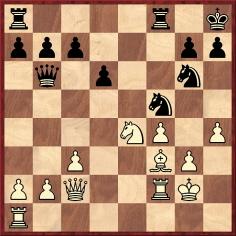
21 Re1 Ne3+ 22 Rxe3 Qxe3 23 Re2 Qb6 24 Ng5 Rf6 25 h5 Nf8 26 Bd5 c6 27 Nf7+ Kg8 28 Nh6+ Kh8 29 Nf7+ Kg8 Drawn.
8119. Kevitz odds game
From the same page of the Brooklyn Daily Eagle:

(Remove Black’s f-pawn.) 1 e4 e6 2 d4 Nf6 3 Nc3 Bb4 4 e5 Ne4 5 Qd3 d5 6 a3 Bxc3+ 7 bxc3 O-O 8 Be3 c5 9 c4 Qa5+ 10 Kd1 Rxf2 11 Ne2
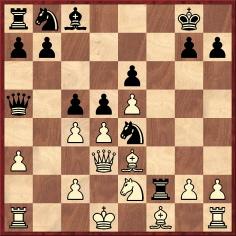
11...b5 12 c3 bxc4 13 Qc2 Bd7 14 a4 Nc6 15 Ke1 cxd4 16 Bxf2 d3 17 Qa2

17...Nb4 18 cxb4 Qxb4+ 19 Kd1 Bxa4+ 20 Kc1 d2+ 21 White resigns.
8120. Impurities
‘Numerous impurities’ are chronicled in our latest feature article.
8121. What should be the result? (C.N. 8083)
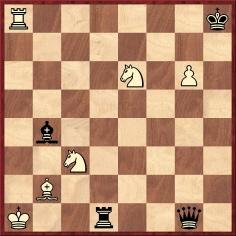
The composition came from page 110 of the February 1893 BCM,
where the caption read ‘By Rev. R.J. Wright, Worthing’ and
‘Either Black or White to move. Adjudicate the position’.
The solution given on page 155 of the March 1893 issue:

8122. Zukertort’s death
From page 322 of the July 1888 Chess Monthly:
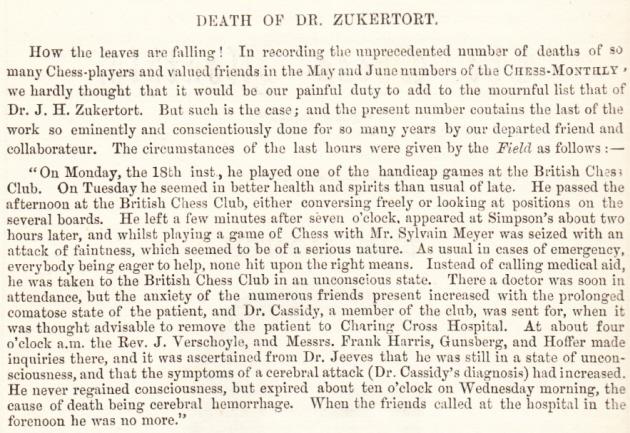
Olimpiu G. Urcan (Singapore) adds some newspaper reports:

Morning Post, 21 June 1888, page 3
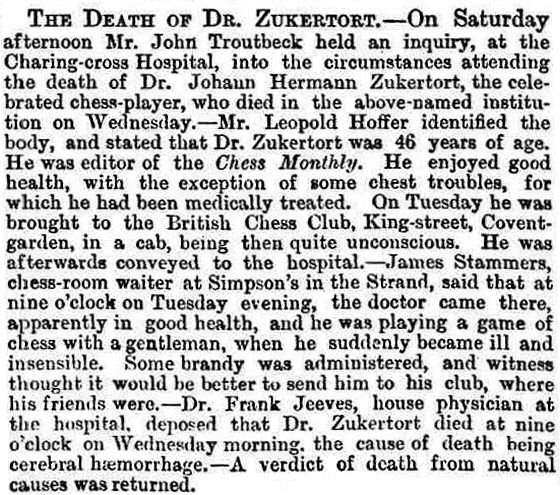
Morning Post, 25 June 1888, page 2
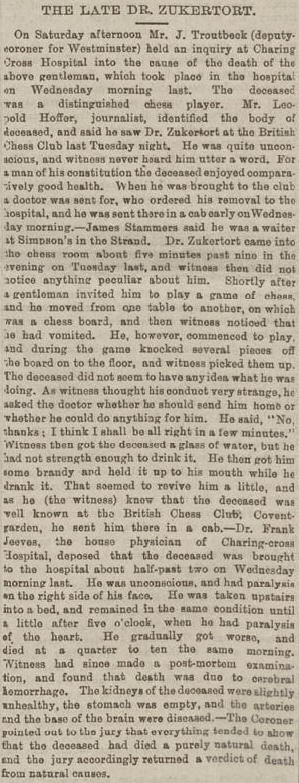
Manchester Courier and Lancashire General Advertiser, 25 June 1888, page 8
The reference to the British Chess Club Handicap Tournament, in which Zukertort was participating at the time, is a reminder of how chess history suffers when Wikipedia entries make do with references to obviously sub-standard sources. The English-language page on Zukertort currently gives links to two articles by Bill Wall, one of which states:
‘He died on 20 June 1888 from cerebral stroke after a chess game during a tournament at Simpson’s Divan. At the time, he was in 1st place. He was scheduled to play Blackburne and Burn in the final two rounds.’
Burn was not even a participant in the tournament.
The crosstable, not widely known, is reproduced below from page 354 of the Chess Monthly, August 1888:
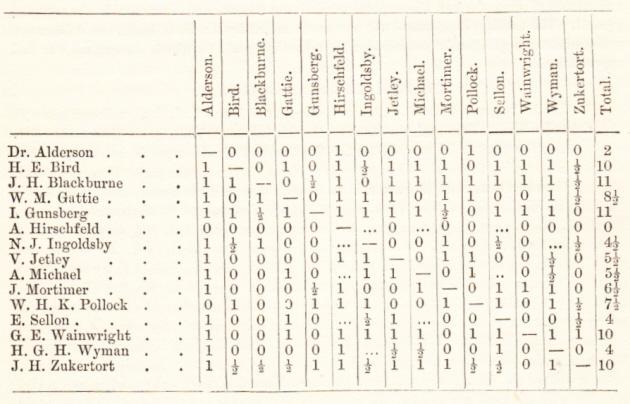
Instead of citing inept Internet articles, the Wikipedia entry on Zukertort would gain from using primary sources and the books written on him:
- J.H. Zukertort by A. Olson (Stockholm, 1912);
- Johannes Zukertort Artist of the Chessboard by J. Adams (Yorklyn, 1989);
- Arcymistrz z Lublina by C.W. Domański and T. Lissowski (Warsaw, 2002);
- Der Großmeister aus Lublin by C.W. Domański and T. Lissowski (Berlin, 2005).
At present, not one of those works is even mentioned in the Wikipedia entry.
8123. Wikipedia
(continued)
‘[Simpson’s-in-the-Strand, London] also hosted the great tournaments of 1883 and 1899, and the first ever women’s international in 1897.’
C.N. 7892 provided documentary proof that all three events took place elsewhere, but the incorrect statement still appears on the Wikipedia page for Simpson’s-in-the-Strand.
8124. Three knights
A position (White to move) given by a correspondent in C.N. 2061 (see page 20 of Kings, Commoners and Knaves):
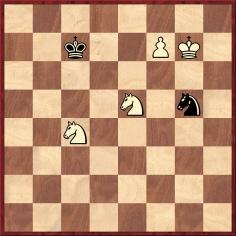
Emil Smilovici (Nepean, Ontario, Canada) asks whether the full game-score (Vujić v Petrović, Yugoslav Ladies’ Championship, 1985) is available.
We can offer only the remaining moves, as published by Tim Krabbé in the source indicated in C.N. 2061 (New in Chess, November 1985, page 57): 74 f8(N) Ne4 75 Ne6+ Kb7 76 Kf7 Ka6 77 Nd4 Kb7 78 Ke7 Nc5 79 Nf7 Kc7 80 Nfd6 Na4 81 N6b5+ Kb7 82 Kd8 Nc5 83 Nbd6+ Ka7 84 Kc8 Nd3 85 Nc6+ Ka6 86 Nb8+ (86 Kb8 mates one move earlier.) 86...Ka7 87 Nb5+
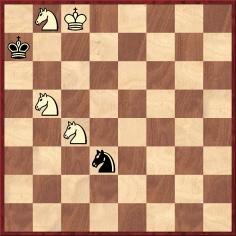
‘and Black resigned; the next move would be mate’.
8125. Spassky v Fischer, 1972
Roy Henock (Eureka, CA, USA) notes a statement at the Huffington Post website: ‘In 1972, Kavalek was Bobby Fischer’s second in his world championship match against Boris Spassky in Reykjavik.’
In terms of presence in Iceland, is it possible to find, or compile, a comprehensive list of seconds, attendants, representatives and officials, with respect to both Fischer and Spassky?
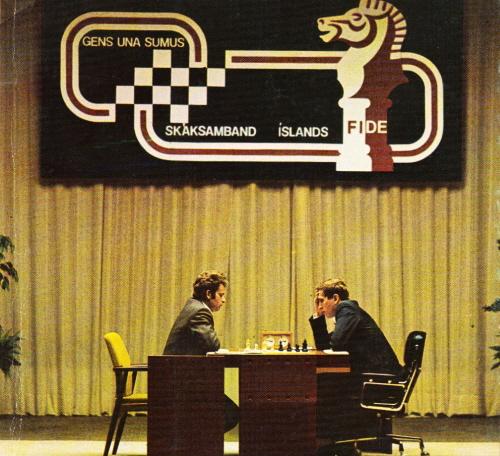
From the front cover of El match del siglo by L.Pachman (Barcelona, 1972)
8126. Prince Leopold (C.N.s 4044, 4066 & 4558)
The consultation game involving Prince Leopold (C.N. 4044) was annotated by Steinitz in his 23 May 1874 column in The Field.
8127. Blackburne v Gifford, The Hague, 1874
A well-known miniature from page 154 of Mr Blackburne’s Games at Chess by P. Anderson Graham (London, 1899):
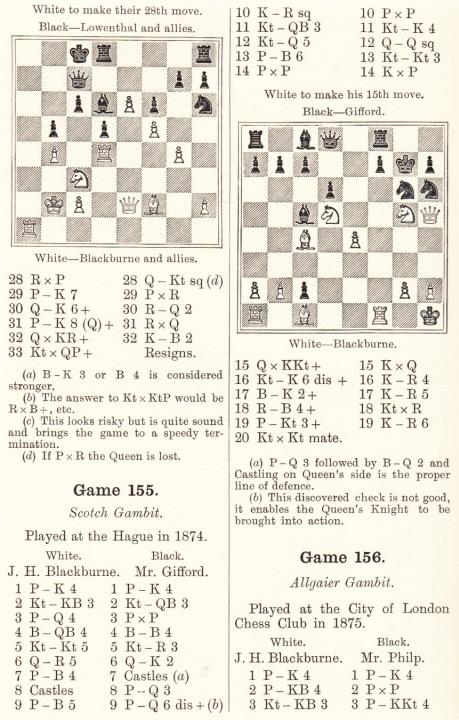
We note, though, that when Steinitz annotated the ‘beautiful little off-hand game’ in The Field, 25 July 1874 he gave a different finish:

16 Nxf7+ Kh5 ‘White announced mate in five moves, viz.: 17 Be2+ Kh4 18 g3+ Kh3 19 Nf4+ Nxf4 20 Rxf4, and mates next move by 21 Bf1’.
That version was also on page 70 of Chess Sparks by J.H. Ellis (London, 1895) and on page 235 of the June 1898 BCM. Wanted: other pre-1899 appearances of the game in print.
8128. Quiz question
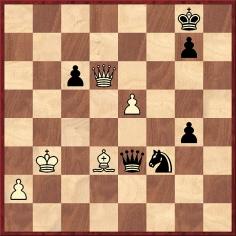
White to move
Where has this position been very widely seen?
8129. Fiske, Hazeltine and the Chess Monthly
From John S. Hilbert (Amherst, NY, USA):
‘Can anyone provide concrete information confirming or contradicting Miron Hazeltine’s assertion that he was co-editor along with Daniel Willard Fiske of the Chess Monthly during 1857? Many years later, and speaking about himself in the third person, Hazeltine wrote that “He was co-editor with D.W. Fiske, A.M., of Vol. I American Chess Monthly” (American Chess Magazine, June 1897, page 7).
On pages 83-84 of Paul Morphy The Pride and Sorrow of Chess (New York, 1976) David Lawson asserted:
“The Chess Monthly was started as a joint venture by Daniel W. Fiske and Miron J. Hazeltine acting as editors and publishers. The first issue appeared in January 1857. However, Fiske observed the rising star of Morphy’s reputation during the Congress in October and wished him to join the magazine as co-editor. Since Fiske was apparently the principle [sic] party of the venture, it seems he eased Hazeltine out. Within a month after Morphy’s arrival in New York, Fiske was expressing the hope that Morphy would be editing with him, beginning in the new year. Before the middle of December the matter was settled, and the printer notified that Morphy and Fiske would be co-editors beginning January 1858.”
Lawson offered no supporting citations for any of his points. I have access only to a reprint of the Chess Monthly, but the title page of that reprint indicates that Morphy and Fiske were editors of Volume I, which apparently was bound early in 1858.
I would appreciate learning what, if any, contemporary sources either confirm or deny Hazeltine’s 1857 association with the Chess Monthly, and, if he was so associated, what evidence survives proving Fiske orchestrated his removal from the publication.’
8130. Wikipedia (C.N.s 8122 & 8123)
Among the many chess oddities on the English-language Wikipedia site are a disproportionately long, though interesting, entry on Grace Alekhine and a Fischer-related page whose three-line section on My 61 Memorable Games ends:
‘Larry Evans originally thought it was possible that it was a pirated version of a genuine Fischer manuscript, but in April 2008 concluded it was a hoax.’
Mr Evans asserted that the 1995 Batsford edition of My 60 Memorable Games was better than the original (see Fischer’s Fury), and there can hardly be value in chronicling what such an individual may have originally thought was possible, or what he later concluded, about My 61 Memorable Games, a book which he never even saw.
Wikipedia frequently neglects figures in the problem world (e.g. A.C. White and P.H. Williams), and it is impossible not to comment slightingly on the thin entries for such masters as S. Alapin, O. Důras and R. Teichmann. On the Teichmann page the sole ‘Reference’ is the 1976 edition of Anne Sunnucks’ The Encyclopaedia of Chess.
There is even a Wikiquote page of chess quotes presented without any sources and obviously therefore needing to be re-started from scratch.
8131. Drawing-room skirmish
In The Field, 9 January 1875 Steinitz provided detailed annotations to this ‘amusing and brilliant drawing-room skirmish [which] occurred some time ago between Mr I.O. Howard Taylor, of Norwich, and an amateur’:
1 e4 e5 2 f4 exf4 3 Nf3 Be7 4 Bc4 c6 5 O-O b5 6 Bb3 Nf6 7 Nc3 O-O 8 d3 Qc7 9 e5 Ng4 10 Bxf4 d6 11 exd6 Bxd6 12 Bxd6 Qxd6 13 Ne4 Qf4 14 Qe2 Re8 15 Rae1 Bd7 16 g3 Qh6 17 Bxf7+ Kxf7 18 Neg5+ Kg6
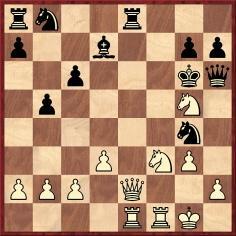
19 Qxe8+ Bxe8 20 Nh4+ Kh5 21 Nh3 Ne3 22 Nf4+ Kg4 23 Rxe3 Nd7 24 h3+ Kg5 25 Ne6+ Kh5 26 Rf5+ g5 27 Nf4 mate.

8132. Cohn
Rod Edwards (Victoria, BC, Canada) asks which player named Cohn won Section IV of the Hastings, 1895 Amateur Tournament. He notes that page 101 of volume one of Jeremy Gaige’s Chess Tournament Crosstables (Philadelphia, 1969) had ‘W. Cohn’, whereas page 225 of A Century of British Chess by P.W. Sergeant (London, 1934) referred to ‘the Berlin player, Erich Cohn’, and page 373 of the September 1895 BCM listed ‘E. Cohn (Berlin)’.
The confusion that may arise between Wilhelm Cohn and Erich Cohn, both from Berlin, was referred to in C.N. 7213. At first sight, Mr Edwards’ question may seem answerable simply by consideration of their dates: Wilhelm Cohn (1859-1913) and Erich Cohn (1884-1918). Clearly, the player at Hastings was not an 11-year-old boy. Given that, furthermore, the crosstable on page 376 of the above-mentioned issue of the BCM had ‘Herr W. Cohn’, the matter may seem settled.
However, the list of participants on page 14 of the September 1895 Chess Monthly put ‘Dr E. Cohn’, as did page 29 of Schallopp’s book on Hastings, 1895 (Leipzig, 1896). (It may be relevant that both publications erroneously listed ‘H.A. Atkins’.) ‘Dr Cohn’ was named on page 3 of Horace F. Cheshire’s The Hastings Chess Tournament 1895 (Hastings, 1896).
The only player named Cohn who was mentioned in the Deutsche Schachzeitung in either 1895 or 1896 was W. Cohn (eight index entries). Two of the three entries for 1895 (August issue, pages 251 and 259) concerned his participation in the Hastings tournament. That event was also mentioned in his obituary on page 315 of the October 1913 Deutsche Schachzeitung:
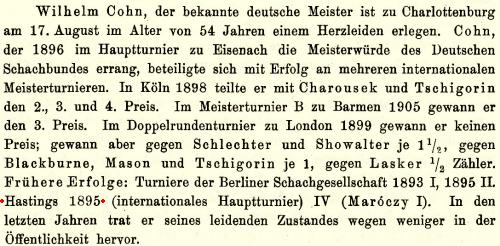
In view of the documentation in German sources (other than Schallopp’s book), it would be remarkable if the player at Hastings, 1895 were not Wilhelm Cohn, but the occurrence of ‘E. Cohn’ in British outlets of the time is strange.
8133. W. Cohn v Swiderski
Swiderski was not quite 18 years old when he lost this game:
Wilhelm Cohn – Rudolf Swiderski
Eisenach, 23 July 1896
Bird’s Opening
1 f4 Nc6 2 Nf3 Nf6 3 b3 d5 4 Bb2 e6 5 e3 Bd6 6 Nc3 O-O 7 Be2 Ne7 8 O-O Nf5 9 Qe1 c5 10 Nb5 Bb8 11 Ne5 a6 12 Na3 Ba7 13 g4 Ne7 14 Bd3

14...b5 15 g5 Nd7 16 Ng4 d4 17 exd4 cxd4 18 Qe4 Nf5 19 Qxa8 Qb6 20 Qg2 Bb7 21 Qh3 Qc6 22 Ne5 Nxe5 23 fxe5 h6 24 Kf2 b4 25 Nc4 f6 26 gxf6 gxf6 27 Rg1+ Ng7 28 Rxg7+ Kxg7 29 Rg1+ Kf7 30 Nd6+ Ke7 31 Rg7+ Kd8 32 Nxb7+ Resigns.
Source: Deutsche Schachzeitung, August 1896, page 241.
8134. The Kings of Chess
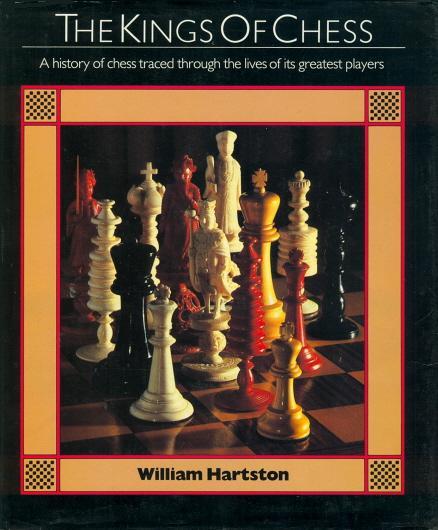
A three-part review of William Hartston’s The Kings of Chess (London, 1985) was written by G.H. Diggle in Newsflash, October, November and December 1985 and reproduced on pages 28-33 of volume two of Chess Characters (Geneva, 1987):
October 1985:
‘On receiving an enthusiastic “tip-off” from that sagacious source, the Chess Editor of the Luton News, the BM lost no time in procuring The Kings of Chess by William Hartston – 192 pages, 15 chapters, and over 100 illustrations, with jacket design by Lawrence Edwards and photography by Ben Johnson. The work, however, is no mere picture book, as the author deals extensively with the careers, characters, contests and controversies of world champions ranging from Philidor to Karpov. As this ground has been covered before – Championship Chess by Sergeant (1939), Kings of Chess by William Winter (1954) and World Chess Champions by Edward Winter (1981), the BM did wonder whether Mr Hartston would have anything new to tell us. In fact, he tells us a great deal – fresh light has been thrown on sundry shadowy episodes of chess history, and there are many shrewd Hartstonian estimates of the great figures who bestrode the chess world during the last 200 years.
To compile a book consisting of individual chapters on successive champions is not as easy as it sounds – their careers are so heavily intertwined that the author has to be constantly on his guard to avoid repetition. However, Mr Hartston has skilfully avoided ever telling the same story twice. Also, though he very occasionally intersperses illustrative games (13 in all, annotated, but not too hoary, apart from our old friends “the Duke and the Count”) they are usually given at the end of each chapter, and not allowed to barge in and dislocate the easy flow of the narrative. In fact, The Kings of Chess is less technical than its predecessors quoted above, and nine-tenths of the book is eminently readable even by a non-chessplayer. The style in which the author treats the “Great Departed” – and indeed the “Still Surviving” – is on the whole kindly, though (as in the lighter How to Cheat at Chess and Soft Pawn) it drips with a sort of harmless malice. Thus, when after dealing with the disagreeable disputes of Steinitz and Zukertort, and later of Capablanca and Alekhine, the author then comes to their amiable successor Dr Euwe, he regards him as a round peg in a square hole and sardonically enquires: “How can such a pleasant chap be a world chess champion?” Again, writing of the absurd dismantling of Fischer’s and Spassky’s match chairs in search of possible “electronic devices”, Mr Hartston is inclined to rap the investigators for negligence, his complaint being that though two dead flies were discovered “no autopsy was performed”.
But the author seems to evince no real dislike of any of the subjects he portrays. This is perhaps not surprising, as when asked on “Karpov v Kasparov” TV recently, “Do you think that a chessmaster finds it a spur and an advantage if he hates his opponent?”, he simply replied, “I don’t know. I’ve never hated anyone”.
The design and photography of the illustrations are admirable. Over half are portraits, and the pudding seems over-egged in certain cases – no fewer than five of Capablanca and six of Alekhine. On the other hand, there are some fine rarities – collective tournament portraits and sketches of Paris, 1867 and London, 1883, and there are even reproductions of old cigarette cards depicting Steinitz and Zukertort at the time of their match in 1886. Many 1972 cartoons of the Fischer-Spassky era appear, and above all there is a very rare contemporary one of Staunton’s final victory over Saint-Amant, with his supporters singing the National Anthem in the background.
Next month the BM hopes to indulge in a few obtrusive comments on what the author has to say about some of the individual masters.’
November 1985:
‘Of no other “King of Chess” have there been more diverse estimates than those of the first one, François André Danican Philidor. Mr Hartston sums him up cautiously, pointing out that all his surviving games were played long after he was in his prime, but adds that his famous Analyse du jeu des échecs, written in his early 20s, assures his place in chess history, if more as a writer than a player. The BM would add that one old French amateur, the Chevalier de Barneville, who had played both Philidor and Labourdonnais, opined that the latter could have given Philidor pawn and two. Other disparagers suggest that, having “hit the jackpot” with one happy punch-line “Pawns are the soul of chess”, he was canonized ever after. But this ignores his “blindfold” skill, his fine endgame analyses (rook and bishop v rook in particular) and the undoubted fact that, though his contemporaries may have been nothing to write home about, he stood head and shoulders above them all for 50 years.
Coming to “renowned Deschapelles”, the author, with – as he says – little evidence to go on outside nine (not very impressive) surviving games, shrewdly surmises that the gasconading Frenchman must have been the strongest player of his time, otherwise no-one would have put up with his “appalling arrogance and unbelievable boasts”. It is indeed true that the chess community, even of those days, would almost certainly rumble any upstart who relied solely on his mouth to reach the top. Yet one feels that if anyone could get away with it, it would be Deschapelles. For like Mr Bounderby in Hard Times, he could not only sing his own praises but somehow stimulate other men to join in – “there was a moral infection of claptrap in him”. Thus George Walker, who had never played Deschapelles or even seen him play, declared: “Deschapelles’ wonderful talent is the most keenly excited in crowded positions. Here that which is Cimmerian darkness to the bystanders is to him light as noon.” But to the student of games, Boncourt rather than Deschapelles was the “Grand Old Man” of French chess.
Next comes the great Howard Staunton, whom the author describes as a deep strategist, with an understanding far ahead of his time, but living in an era when tactics were still the rule. Though he does not minimize Staunton’s pomposity and his “indisposition” whenever the day was against him, Mr Hartston is quite fair to the great man except at one point. Writing of the illness in 1844 which prevented the third match with Saint-Amant, the author says: “Whether the illness was genuine, or a convenient excuse, it is hard to judge.” But it was undoubtedly genuine. All the “archives” dealing with this illness are not readily accessible, but they reveal decisive corroborative evidence from such respectable sources as Captain Wilson (Staunton’s second) and T.J. Bryan, the wealthy and generous American who befriended him during his convalescence. In fact, Staunton never pleaded illness to avoid a match, though he undeniably pleaded it whenever he lost one. The BM has one satirical pamphlet, written after the 1851 tournament, which describes how (in the pro-Staunton press) “the Great Athlete of Calculation” having beaten Horwitz “in Cloud Compelling style”, suddenly shrivelled in the next round against Anderssen into “an invalid, utterly unfit by suffering and physical exhaustion to maintain his reputation in these encounters”.
Dealing with “Morphy, the Unhappy Genius”, the author, who has availed himself of David Lawson’s great work, convincingly rebuts the idea prevailing amongst many previous “pundits” (including, alas!, the BM) that Morphy’s fits of aversion to chess as early as 1858 were the first signs of persecution mania. “His irrational phases”, W.R.H. points out, “formed only two short periods of his life”, and the first symptoms “only appeared 15 years after he had renounced chess”.
On Wilhelm Steinitz, with his ferocious journalism and his extreme unpopularity in this country, the author throws some interesting light. According to Mr Hartston, Victorian snobbery was as much to blame as Steinitz. “A complex etiquette prevailed in the Clubs, whereby any foreigner was received with open arms as long as he was sufficiently deferential to his hosts.” Steinitz failed to maintain the required standard of “’umbleness” and was ostracized accordingly. With all his violent temper, he seems to have been a warmer hearted man than his great rival Zukertort, and less of an exhibitionist. O.C. Müller, a fellow professional of the 1880s, surprisingly writes (BCM, November 1932): “I always found him ... very amiable but of a rather quiet and retiring disposition. ... He did me various good turns ... and he will for ever live in my memory as a kind friend and one of the greatest chess masters of the last century. The last time I saw him was during and after the Aquarium Tournament in 1899, when he spent a week or so in my house before returning to New York, where he died in 1900”.’
December 1985:
Mr Hartston devotes two chapters to Emanuel Lasker, in which he conveys to the reader admirably the atmosphere of genius mingled with bluff and tightrope walking which pervaded the great master’s long career. In tournaments, writes W.R.H., he was always “viewing the game as if looking over his opponent’s shoulder”. He would make bad moves with a straight face just to keep the man opposite suspicious, hesitant and uncomfortable. As the author brilliantly puts it, he “led his opponents through quagmires of unresolved tension until they sank under the weight of their own worries”. (BM footnote: Even as an authority and “pundit” he would sometimes pull the wool over people’s eyes. When an eminent chess author once asked him whether posterity had awarded too much praise to Steinitz and too little to Staunton, the wily Doctor, whose Manual reveals no indication that he had ever studied Staunton at all, gravely “agreed that it was possible”.)
Capablanca in his youth was by no means blind to his own genius, and Mr Hartston entertains us with divers “illustrative quotations” from My Chess Career. But his sense of fun runs away with him in recommending the book as “compulsory reading for students of chess vanity” – it caters equally for students of chess. Moreover, he might also have quoted some of Capa’s notes to his six losses published in Chess Fundamentals, justly described by W.R.H. as one of the finest elementary treatises ever written on the game. The notes are honest, free from bias and not ungenerous. For example, v Znosko-Borovsky (an unexpected loss against an inferior master) where Staunton would have said “The play on both sides is incredibly weak” (S. 0 Horwitz 1) Capa writes: “Black deserves great credit for the way in which he conducted this exceedingly difficult defence. He could easily have gone wrong any number of times, but from move 22 onwards he always played the best move.”
Coming to Alekhine, the author again does not ignore the debit side, particularly when dealing with “The Great Chess Feud” (with Capablanca). But except in this particular field, Alekhine never struck the BM (who observed him at several congresses) as a venomous or arrogant man, and his demeanour towards Badmasters and Plebeians was by no means that of a Coriolanus. The curious thing was that though he undoubtedly hated Capablanca (a defeated rival from whom he had won the title) he never bore the slightest ill-will to Dr Euwe, by whom he was so unexpectedly toppled in 1935. At the beginning of the Nottingham Congress last round in 1936, Euwe (though still world champion) was in some danger of not getting into the prize list, while Alekhine himself (who had the bye) was already out of the running unless Euwe, Fine and Reshevsky either drew or lost. In the event they all won, Euwe being extremely lucky not to have lost against Sir George Thomas. Yet the BM saw Alekhine walk up to the champion afterwards, and with a pleasant smile shake him warmly by the hand.
And now the author arrives at “the land of the living”. His chapters 11, 12 and 13 on the conception, organization and planning of Soviet Chess Supremacy, founded by that sinister but remarkable man, Nikolai Krylenko, State Prosecutor of the 1920s and 1930s, are among the most gripping of the book. And of all the Soviet world champions “the system” has produced, Mikhail Botvinnik emerges, if not the greatest player, the greatest national figure and institution – a sort of Bank of England of Russian Chess; the hallmark of continuity. Twice temporarily deposed, he at once fought back and regained the throne – his prestige never seemed to suffer from an occasional reverse – and to have maintained the successive friendships and confidence, first of Krylenko and then of Molotov, throughout a rugged and chaotic period covering 15 years, denotes a man of exceptional character.
The news has just come through that the last great figure in Mr Hartston’s story, Anatoly Karpov, is world champion no more, having gone down to the youngest man who has ever earned the title (if we except Paul Morphy). The BM’s favourite newspaper (of a true blue texture, of course) expatiates with some relish on the Kremlin’s supposed embarrassment at the result, and concentrates joyously on ringing in the new champion rather than ringing out the old, who is depicted as fading from our sight in a mist of doubt and “shame”. But in his final chapter Mr Hartston has this to say of the man who, though he succeeded to the title by default, held on to it unflinchingly for the last decade: “Anatoly Karpov had emerged from the Soviet cauldron just when he was most needed ... [He] became the most active world champion for many years, and the most successful of all time. He travelled from tournament to tournament, playing all his most dangerous opponents, only very rarely failing to take first place.”’
8135. Spassky v Fischer, 1972 (C.N. 8125)
From Lubomir Kavalek (Reston, VA, USA):
‘I wrote about my role during the 1972 world championship match in an article on pages 60-68 of the 6/2012 New in Chess. It includes transcripts of two interviews with Fischer.
In brief, I took over the second’s duties during the adjournment of the 13th game after Fischer sent Lombardy away. I was analysing with Fischer alone until the end of the match. We also spent time walking together, swimming and bowling. To my knowledge, there were only three other people (Bill Lombardy, Fred Cramer and Brad Darrach) who had daily contact with Fischer away from the playing hall. I was also busy reporting for the Voice of America. I know that there was a list of the invitees to the closing ceremony; since Lombardy was the official second, I was listed as “Bobby Fischer’s coach – bowling”, although I bowled only three times in my life. However, it enabled my wife and me to sit at the same table with Bobby and Boris Spassky.’
We add a brief excerpt from Lubomir Kavalek’s above-mentioned article in New in Chess (page 66):
‘It was during this game [the 13th] that I started working with Bobby on the adjournment games after he sent his official second, Bill Lombardy, away from his suite. Bobby and Bill were a great pair, but during that night they turned into two strong personalities with two different opinions. The tension was resolved by Lombardy’s sneeze. “I don’t want to get your cold, Bill”, Bobby said and added he wanted to work with me. Bill left quietly.
From that moment on, I analysed just with Bobby till the end of the match.’
8136.
Icelandic Chess Federation programme (Spassky v
Fischer match)
Alan McGowan (Waterloo, Canada) forwards page 2 of the Icelandic Chess Federation’s Commemorative Programme (New York, 1972):

8137. Quiz question (C.N. 8128)
C.N. 8128 gave a position and asked where it had been very widely seen (by millions of non-chessplayers, in fact). The illustration below may help:

8138. Chess Masters in Action (C.N.s 6587 & 6596)
Olimpiu G. Urcan (Singapore) has found the full, original version of C.H.O’D. Alexander’s article, on pages 610-611 of The Listener, 16 October 1958:
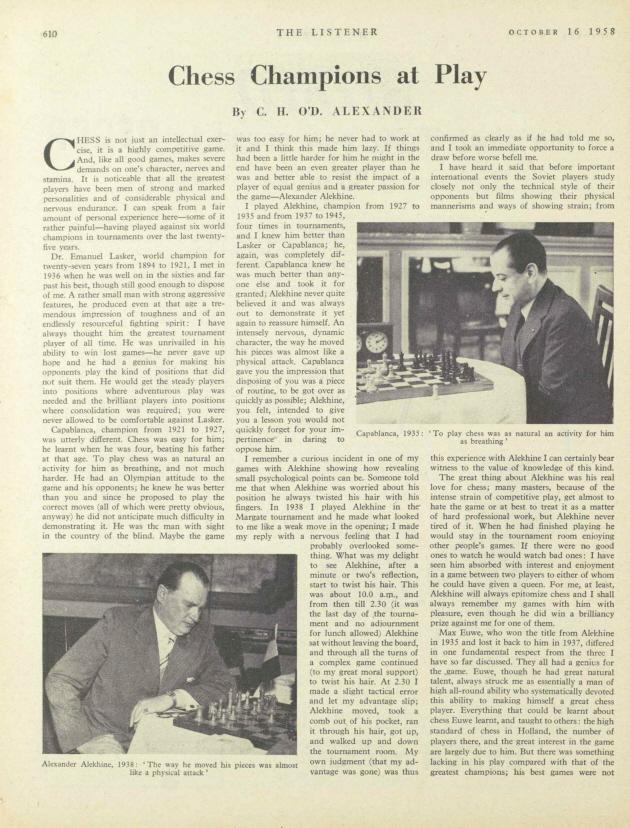
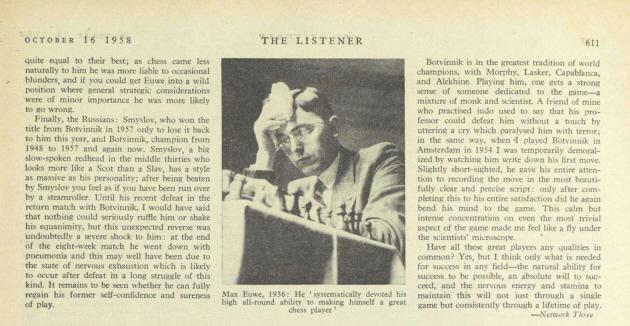
The ensuing correspondence published in The Listener (6 November 1958, page 741 and 13 November 1958, page 786) focused on Edgar Allan Poe:
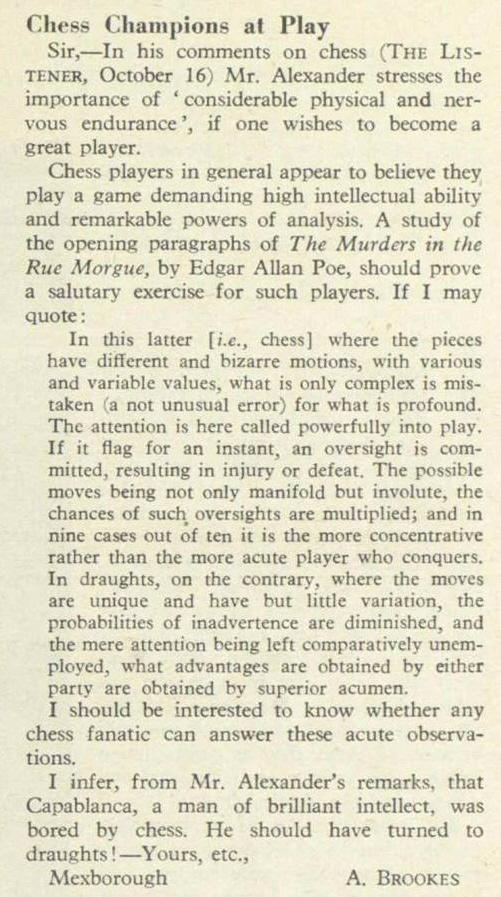
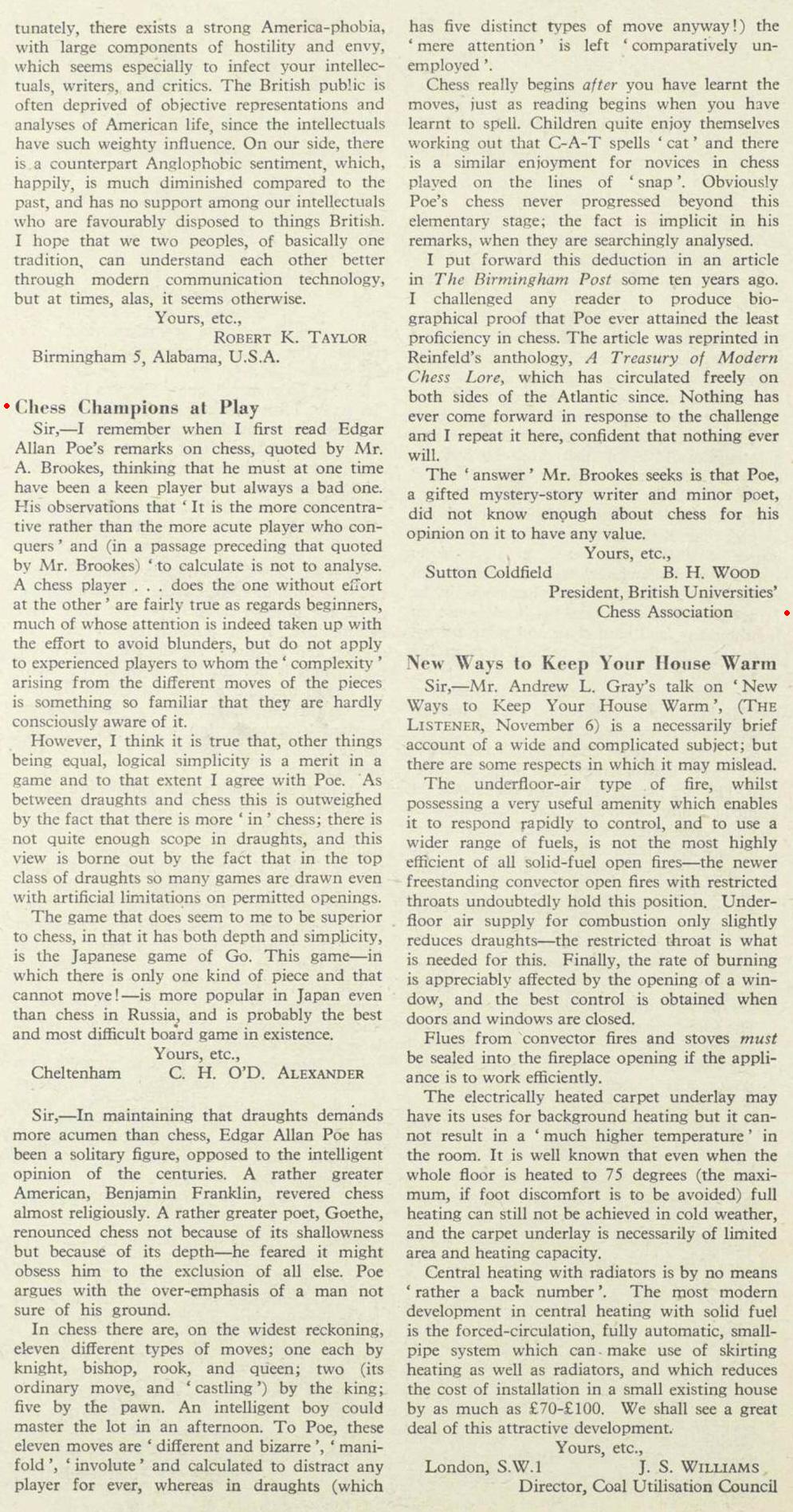
8139. Psychiatry, Lunacy, and Chess
Mr Urcan has also supplied an article by Gerald Abrahams from pages 743-744 of The Listener, 27 October 1960:
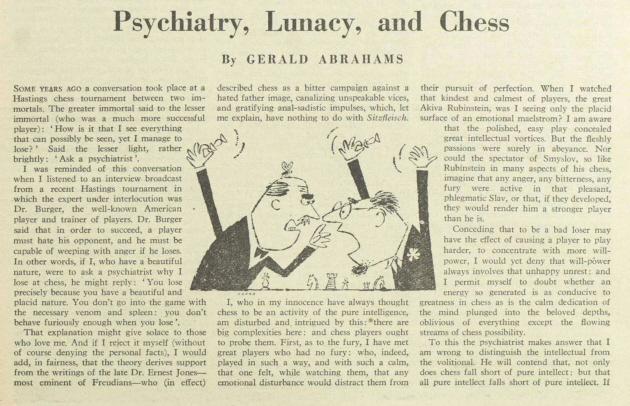

The text is markedly different from the article of the same title reproduced on pages 26-36 of Abrahams’ book Not Only Chess (London, 1974).
8140. Marshal Tito (C.N.s 5293 & 8052)
A third contribution from Mr Urcan is a feature about Marshal Tito on pages 8-9 of Picture Post, 24 August 1946:
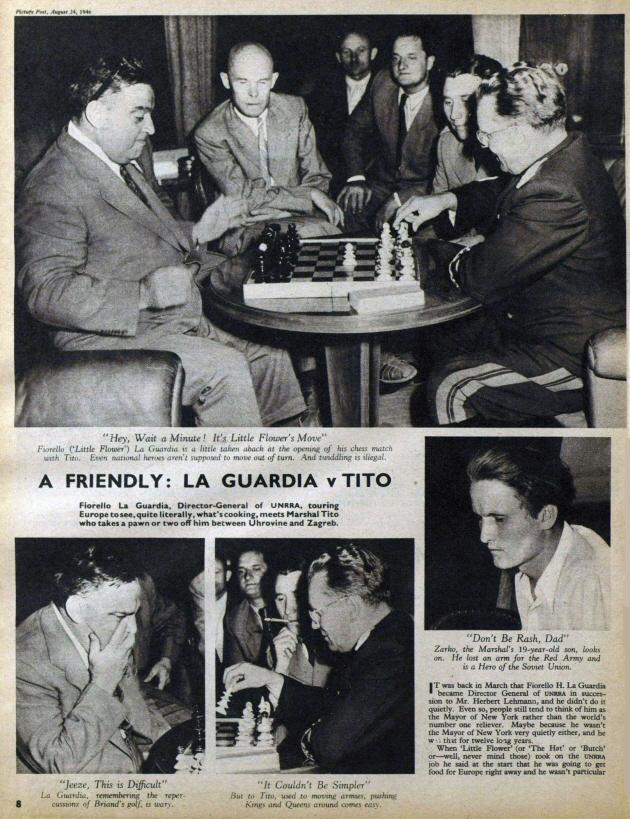

8141. National championship
Alan McGowan (Waterloo, Canada) reports
that in Helensburgh on 14 July 2013 Roddy
McKay became Scottish champion for the eighth time,
having first won the title (jointly) in 1971. Our
correspondent asks whether this spread of 42 years in the
same national championship has been matched or surpassed
by any other players.
8142. More of the same

Half a dozen typos in half a dozen lines.
Source: page 12 of a book published by Impala Film Division in 2008: Battle of Bonn (World Chess Championship 2008) by Raymond Keene and Eric Schiller.
8143. Quiz question (C.N.s 8128 & 8137)

This shot comes from the episode ‘Checkmate’ in the ITC series The Prisoner, first broadcast in 1967. Below, from the same scene, is Patrick McGoohan writing on the newspaper:
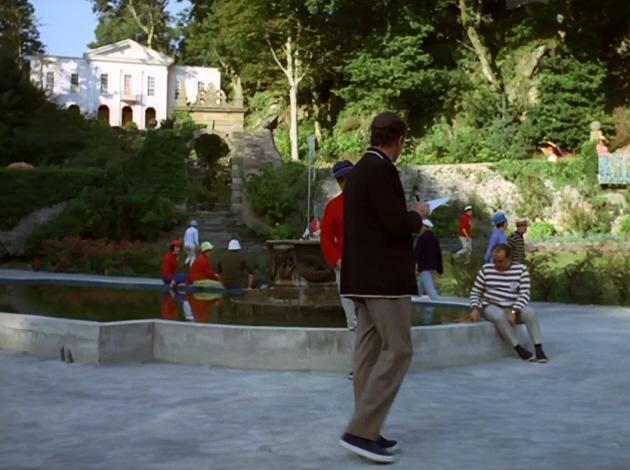
The episode features a game of living chess in ‘The Village’:
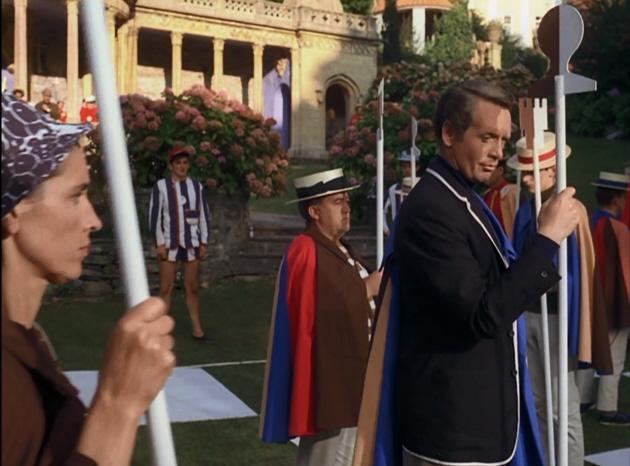
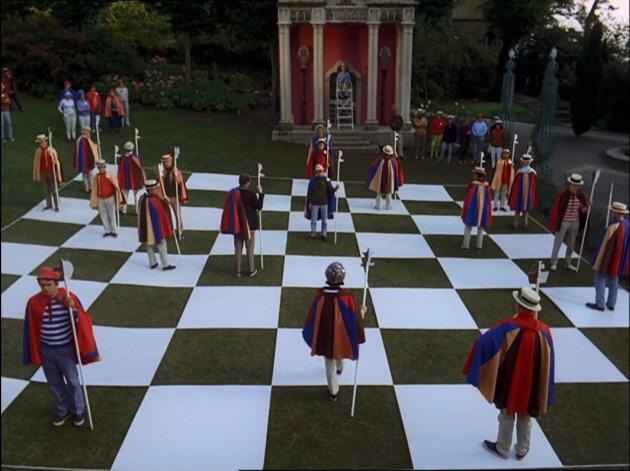
There is a detailed summary of the episode on pages 156-160 of The Prisoner & Danger Man by Dave Rogers (London, 1989). Page 160 states that its working title was ‘The Queen’s Pawn’ and gives this summary of the final scene:
‘In the control room the mute Butler, his face a mask of complacency, places a yellow-coloured pawn back onto its rightful position on his superior’s chessboard.’
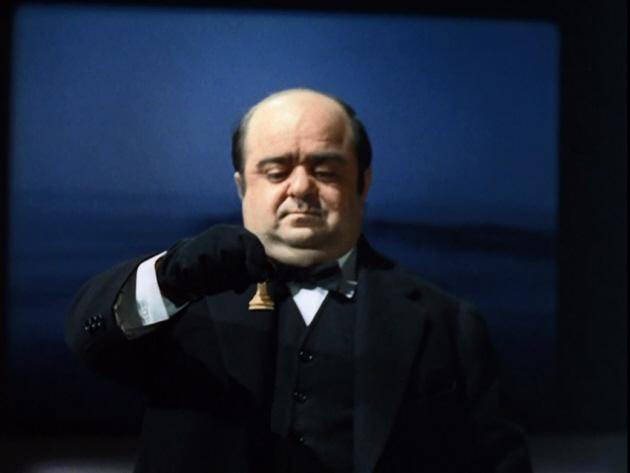
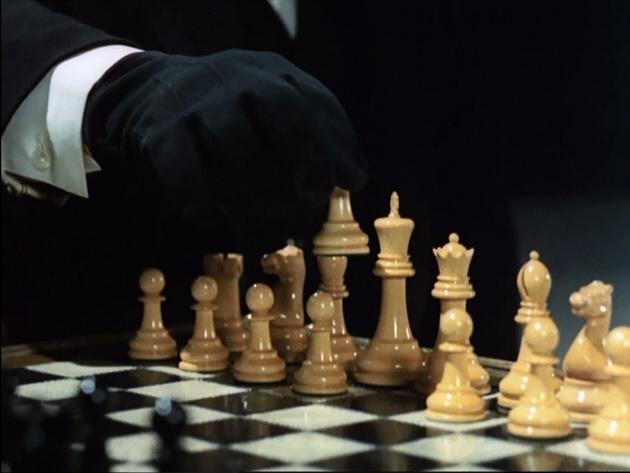
From page 142 of the book:
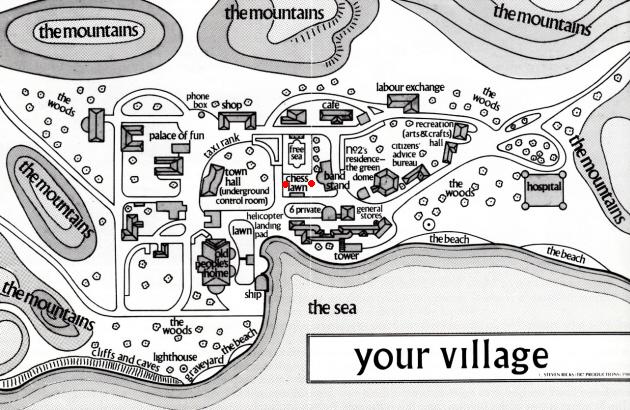
In the newspaper screenshot given in C.N. 8137 there were two clues relating to typeface, as noted by Alan O’Brien (Mitcham, England): the heading ‘chess’ in the Albertus lettering used by The Prisoner throughout the series and, for the text of the column, the typeface of the Evening Standard (London).
The latter is a point that we mentioned to the chess
columnist of the Standard, Leonard Barden, some
years ago. The reference number (7744) at the foot of the
diagram should allow the edition of the newspaper to be
identified, but Mr Barden informs us that he no longer has
a record of the position or the date of its appearance.
Can any reader trace further information, including, of
course, the players’ names?

The win missed by White is 1 Qd8+ Kf7 2 e6+, followed by 3 Qe8+ or 3 Bc4.
8144. National championship (C.N. 8141)
Michael McDowell (Westcliff-on-sea, England) comments that Howard Williams won the Welsh championship 43 years apart, in 1968 and 2011.
Confirming this to us, Howard Williams (Cardigan, Wales) writes:
‘It is, though, fair to point out that in both 1968 and 2011 I tied for first place with somebody else. (There were no arrangements to split ties on either occasion, and the title was simply held jointly.)’
From C.N. 8141 it will be recalled that Roddy McKay’s first Scottish championship title, in 1971, was also a joint victory.
8145. Unsafe
Many chess books persist with the lazy, naïve practice of vacantly plucking sourceless quotes and other unsafe material from the Internet. To mention just one recent volume, of which Everyman Chess may, in retrospect, feel ashamed: Chess Psychology: The Will to Win! by William Stewart (London, 2013).
8146. The Prisoner (C.N. 8143)
Etienne Cornil (Braine-l’Alleud, Belgium) draws to our attention his article ‘Le Prisonnier’ on pages 9-11 of Le Journal du C.R.E.B., July-August 2005.
8147. Cornered
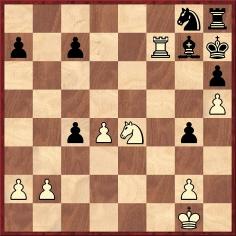
Black resigned.
‘One of the most elaborate blockades and Zugzwangs ever’ and ‘altogether a most wonderful conception’. So wrote Bruce Hayden about a game on pages 58-61 of Cabbage Heads and Chess Kings (London, 1960):
1 e4 e5 2 Nc3 Nc6 3 f4 exf4 4 Nf3 g5 5 h4 g4 6 Ng5 h6 7 Nxf7 Kxf7 8 d4 d5 9 Bxf4 dxe4 10 Bc4+ Kg6 11 O-O Bg7 12 h5+ Kh7 13 Be5 Bxe5
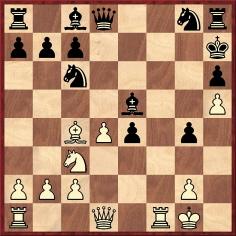
14 Rf7+ Bg7 15 Nxe4 Qxd4+ 16 Qxd4 Nxd4 17 Raf1 Bf5 18 c3 b5 19 cxd4 bxc4 20 R1xf5 Re8 21 Re5 Rf8 22 Ree7 Rxf7 23 Rxf7 Resigns.
The book merely stated that ‘Herr Hartewige’ won the game in Chemnitz in 1901. When Hayden originally published the item (Chess Review, March 1953, pages 76-77), the loser was mysteriously named as ‘Herr Neinzwanger’.
White was Emil Johann Hartewig (1861-1932), and when he annotated the game on pages 174-175 of the June 1902 Deutsche Schachzeitung he identified his opponent as ‘R. F....i’:
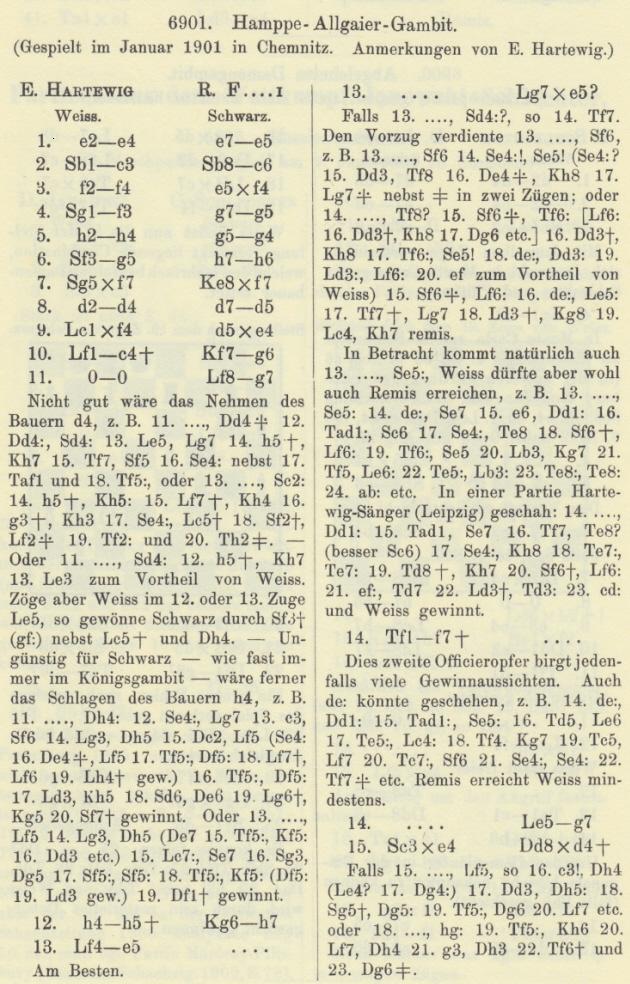
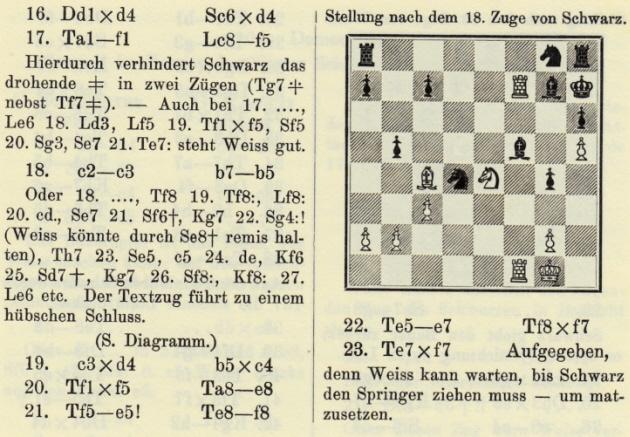
Can any further details be found?
8148. Kottnauer v Lang
From a simultaneous exhibition:
Čenĕk Kottnauer – Lang
Rapperswil, 31 January 1953
Falkbeer Counter-Gambit
1 e4 e5 2 f4 d5 3 exd5 e4 4 d3 exd3 5 Qxd3 Nf6 6 c4 c6 7 Nc3 Bb4 8 Bd2 O-O 9 O-O-O Qa5 10 a3
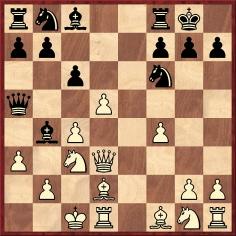
10...Bxa3 11 bxa3 Qxa3+ 12 Kc2 Na6 13 Nb1 Qa2+ 14 Kc1 Nc5 15 Nf3 Bf5 16 Bb4 Nxd3+ 17 Bxd3 Bxd3 18 Rxd3 Qxc4+ 19 White resigns.
Source: Schweizer Arbeiter Schach Journal, June-July 1953, pages 85-86.
8149. Kostić in Uruguay
Juan Vargas – Boris Kostić
Montevideo, 1913
Ruy López
1 e4 e5 2 Nf3 Nc6 3 Bb5 a6 4 Ba4 Nf6 5 d4 exd4 6 O-O Be7 7 e5 Ne4 8 Nxd4 Nc5
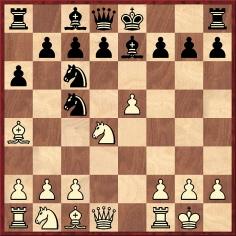
9 Nf5 h5 10 Nxg7+ Kf8 11 Nxh5 Nxe5 12 Nc3 d6 13 h3 Nxa4 14 Nxa4 Bxh3 15 Nf4 Bg4 16 f3 Bd7 17 Nc3 Bh4 18 Ne4 Bb5 19 Ne2 d5 20 N4c3 Qd6 21 Nxb5 axb5 22 Bf4 Ra4 23 Be3
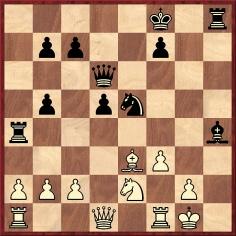
23...Ng4 24 fxg4 Qh2+ 25 Kxh2 Bf2+ ‘and mate next move’.
Source: Capablanca-Magazine, 31 December 1913, page 235.
8150. The Prisoner (C.N.s 8143 & 8146)
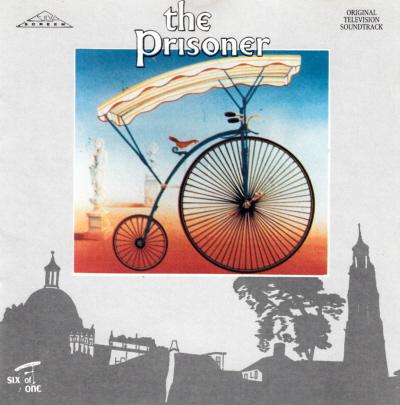
Gerd Entrup (Herne, Germany) found what we shall term ‘the Prisoner position’ on page 93 of the seventh edition of Kurt Richter’s Kombinationen (Hollfeld, 1995). The players’ names were rendered as Lie and Dresler, and the only other information was that the game came ‘aus einem nordischen Fernturnier, um 1932’ (from a Nordic correspondence tournament, circa 1932).
Checking back through the earlier editions of Richter’s book, we noted that in the first two (Berlin, 1936 and Berlin, 1940) the position was given, on page 85, with the same vague data but a different spelling of Black’s name: Desler.
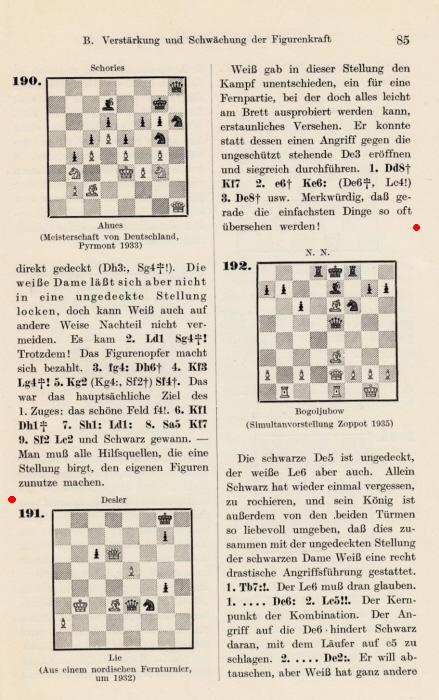
Peter Anderberg (Harmstorf, Germany) kindly undertook further investigation, and his findings are given below:
‘The position was published in Schachwart, December 1932, page 234 with the same wording as in Richter’s book (“aus einem nordischen Fernturnier”):
The complete game was given, with notes by Lie and Desler, in the Danish magazine Skakbladet, July 1932, pages 102-103, under the heading “Fra Korrespondancematchen om Mesterklassens 2. Præmie ved Turneringen i Svendborg 1930”; it was followed by a second game, in which Desler played White, under an identical heading:

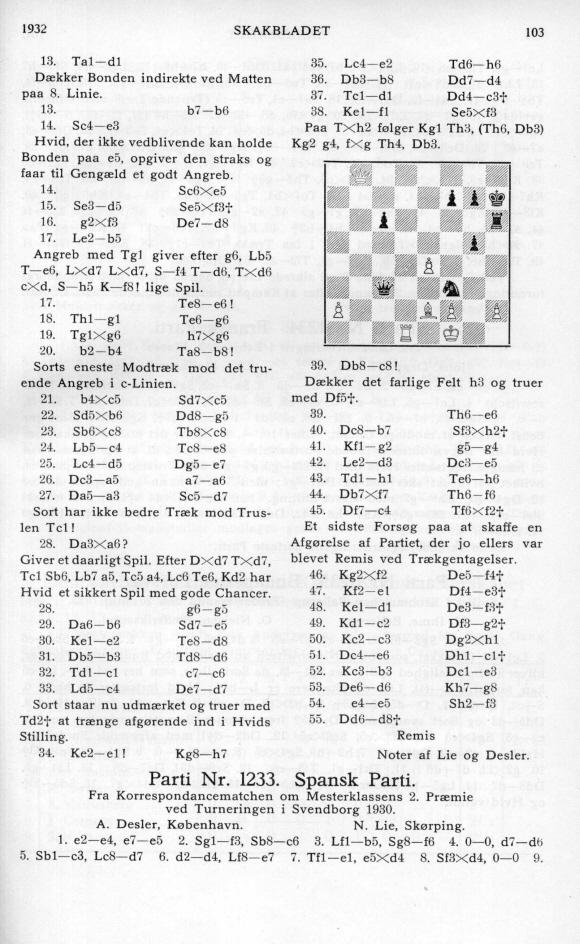
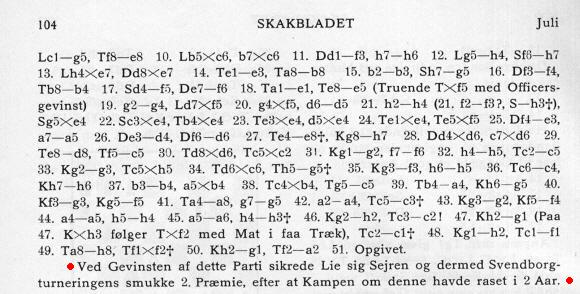
The conclusion of the Lie v Desler game was published on page 123 of the following issue of Skakbladet (August 1932), where the missed win was pointed out by H.F. Rentoft of Aarhus:
The two correspondence games were played to resolve the tie between Desler and Lie for second and third places in the 1930 Danish (over-the-board) championship in Svendborg, as reported in Skakbladet, June 1930, pages 82-83):’

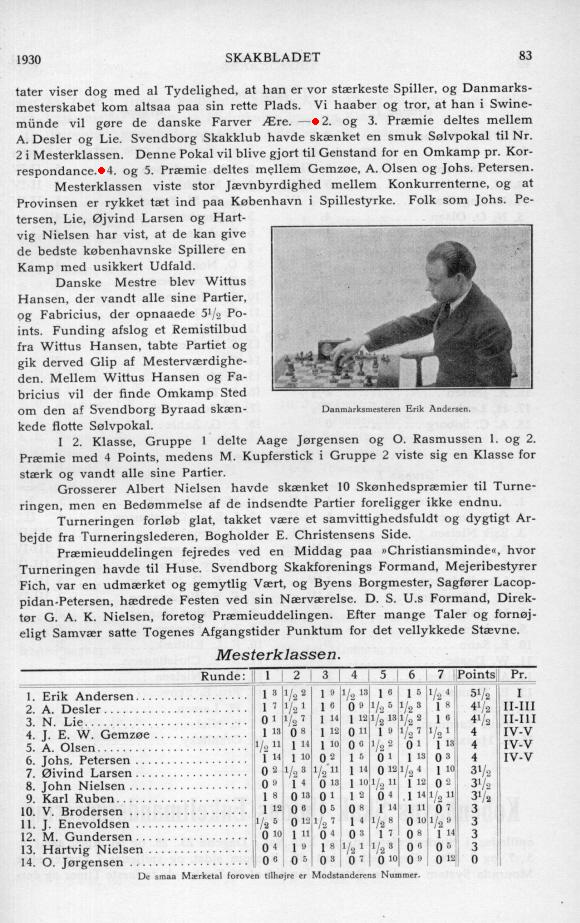
Below is the full score of the correspondence game (Niels Lie v Arne Desler) whose finish appeared in The Prisoner:
1 d4 Nf6 2 Nf3 e6 3 c4 Bb4+ 4 Bd2 Qe7 5 Qc2 Bxd2+ 6 Nbxd2 d6 7 e4 e5 8 c5 dxc5 9 dxe5 Nfd7 10 Qc3 O-O 11 Be2 Re8 12 Nc4 Nc6 13 Rd1 b6 14 Ne3 Ncxe5 15 Nd5 Nxf3+ 16 gxf3 Qd8 17 Bb5 Re6 18 Rg1 Rg6 19 Rxg6 hxg6 20 b4 Rb8 21 bxc5 Nxc5 22 Nxb6 Qg5 23 Nxc8 Rxc8 24 Bc4 Re8 25 Bd5 Qe7 26 Qa5 a6 27 Qa3 Nd7 28 Qxa6 g5 29 Qb5 Ne5 30 Ke2 Rd8 31 Qb3 Rd6 32 Rc1 c6 33 Bc4 Qd7 34 Ke1 Kh7 35 Be2
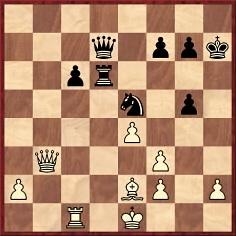
35...Rh6 36 Qb8 Qd4 37 Rd1 Qc3+ 38 Kf1 Nxf3 39 Qc8 Re6 40 Qb7 Nxh2+ 41 Kg2 g4 42 Bd3 Qe5 43 Rh1 Rh6 44 Qxf7 Rf6 45 Qc4 Rxf2+ 46 Kxf2 Qf4+ 47 Ke1 Qe3+ 48 Kd1 Qf3+ 49 Kc2 Qg2+ 50 Kc3 Qxh1 51 Qe6 Qc1+ 52 Kb3 Qe3 53 Qd6 Kg8 54 e5 Nf3 55 Qd8+ Drawn.
8151. Uncomfortable questions
Grandmaster A turns up at the board in an apparent drunken haze and falls asleep (or ‘promptly falls asleep’, as the accounts are more likely to say).
Grandmaster B refuses a pre-game handshake with his opponent because of personal problems between the two players (it is reported that they have ‘a history’).
Grandmaster C is suspected of wiring himself up to an electronic device in an attempt to cheat during a game (the affair is instantly and inevitably baptized any old thing plus the ‘gate’ suffix).
Such happenings in the chess world invariably ignite knee-jerk analysis (‘chat’), offering everyone merciful relief from having to discuss chess. Writers (including those individuals who incongruously combine pseudonymity with self-importance in forum discussions) chew over the rights and wrongs of the case, without knowing the facts or even whether there is a case. We are informed what they feel perhaps happened, what their best guess would be, what they would not be surprised by, what they think they once read somewhere, and what they deem a fitting punishment in view of what they ‘reckon’ occurred. If much of the discussion (dressed up, where possible, as ‘breaking news’) is expressed in prose dashed off without concern for spelling, grammar or anything else, that is a small price to pay for immediacy and the common goal of making the affair ‘go viral’. All the writers can then feel that they have been in on something worthwhile and have done their bit within the chess community.
Should it turn out that, for instance, Grandmaster A’s alcoholic intake was zero and that his drowsiness was caused by problems concerning (‘issues with’) medication, that will not be allowed to put a damper on the fun. Any such correction – not explicitly presented as a correction, of course – will merely open up fresh vistas for comment and speculation from a different angle; after all, drug-taking and drug-testing are notably fertile ground for those wishing to comment and pass judgment, unencumbered by the need to know anything. And so the whole spiel resumes. ‘Freedom of expression’ (i.e. scattergun imputations) can start anew, and a good time is had by all, except by those who care about truth and, more personally, those whose reputations are damaged, or even wrecked, in the maelstrom of misinformation and conjecture.
Now, exeunt Grandmasters A, B and C, and enter Grandmaster D. He is the subject not of gossip or scandal-mongering but of grave, incontrovertible disclosures about his conduct: it has now been demonstrated as a matter of public record that, quite apart from his slew of transgressions over the decades, he has presented other people’s writing as his own not just a few times, as was previously thought, but again and again.
C.N. 8099 briefly referred to Raymond Keene’s plagiarism, but since then the scale of it has become evident from the continuing series of articles by Justin Horton at the Streatham & Brixton website. Readers can examine the eye-popping details for themselves via a convenient ‘plagiarism index’ which is being kept updated.
Executive summary: in addition to shuttling his own writing, or what was imagined to be, from one Times or Spectator column to another (his columns being pale shadows of their former pale shadows), Raymond Keene has often used those outlets to pass off material, particularly from the Kasparov Predecessors books, as his own writing. It is not just occasional phrases, sentences or paragraphs that have been misappropriated, but material to fill entire columns. And, we now know, frequently.
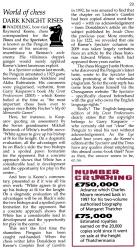
Page 29 of the 28 June-11 July 2013 issue of Private Eye (a feature nearly 90 lines long – shown above in a small format for illustration only) discussed bluntly the behaviour of ‘this absurd comic-book thief’, but what can be said about the chess world’s reaction, or lack thereof, to the affair? To date, it has been a case of ‘lack thereof’. Such pusillanimity is nothing new, there being a longstanding belief among editors (including his employers) that the best place for unsavoury information about Raymond Keene is under the carpet. Now, though, given the sheer extent and seriousness of what he has done, why would any editors or columnists (and not only British ones) wish to continue concealing the facts from their readers? After all, if they were to persist in shielding Raymond Keene, how could they legitimately criticize anybody else for anything?
8152. Matches and tournaments (C.N. 5792)
C.N. 5792 sought information about the origins of a remark attributed to Tartakower on page 159 of The Chess Scene by D. Levy and S. Reuben (London, 1974):
‘Matches prove less than tournaments; and tournaments don’t really prove anything either.’
The only progress to report is that the identical wording appeared in a set of eight alleged Tartakowerisms on page 178 of CHESS, 25 February 1956. Since the magazine furnished sources for none of them, the progress is minuscule.
8153. Ortueta v Sanz
Capablanca’s annotations to this famous game, from pages 39-41 of El Ajedrez Español, February 1936:
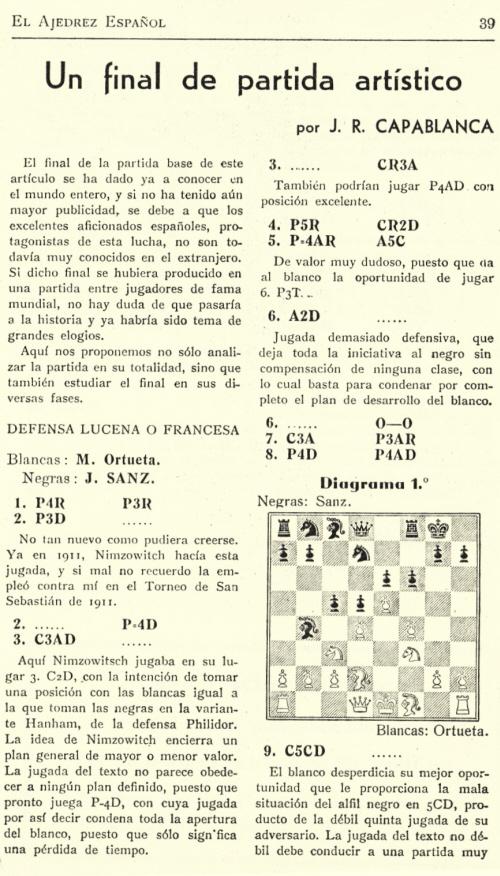
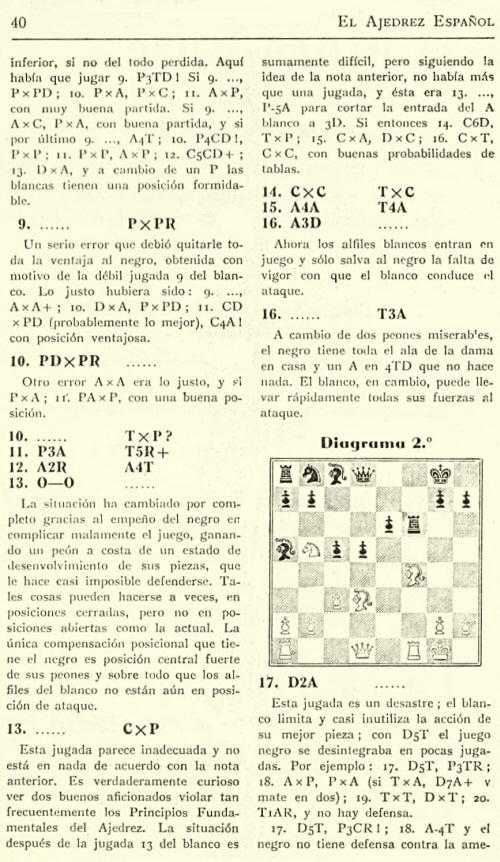

For an English translation, see pages 258-259 of our book on Capablanca.
We wonder whether any details are available concerning Rinck’s reaction when shown the finish, according to Tartakower on page 586 of L’Echiquier, 8 August 1934:
‘M. Rinck, à qui on avait montré cette finale, déclara tout ce qui suit d’une perfection artistique. “Vous voulez que j’en forge une étude”, a-t-il dit: “mais l’étude est déjà toute forgée, où il n’y a rien à ajouter, ni à retrancher.”’
Another question concerns the grounds, if any, that Koltanowski had for stating on pages 96-97 of Chessnicdotes II (Coraopolis, 1981) regarding 34...a5:
‘This move took Sanz 45 minutes to work out and, according to him, was the most difficult of the whole “finale”.’
According to Bruce Hayden (in an article about the game in Chess Review, May 1964, pages 136, 137 and 159) the move on which Black consumed that amount of time was 31...Rxb2:
‘After 45 minutes’ thought, Sanz had produced a thunderbolt with a rook sacrifice heralding one of the most remarkable endgames in the history of chess.’
For detailed information about the game, see Strangest Coincidence Ever – or Hoax? by Tim Krabbé.
8154. Foretaste
1 g4 e6 2 f4 Qe7 3 Na3 Qf6 4 Rb1 Qg5 5 b4 Qf6 6 Rb3 Qe7 7 Rc3 Qd8 8 Rc4 Qe7 9 Bb2 Qf6 10 Be5 Qg5 11 Bd6 Qf6 12 Rxc7 Qe7 13 Rxc8+ Qd8 14 Nb5 a5 15 Nc7 ‘Resigns’.
8155. The Art of Annotation by A. Njubeu
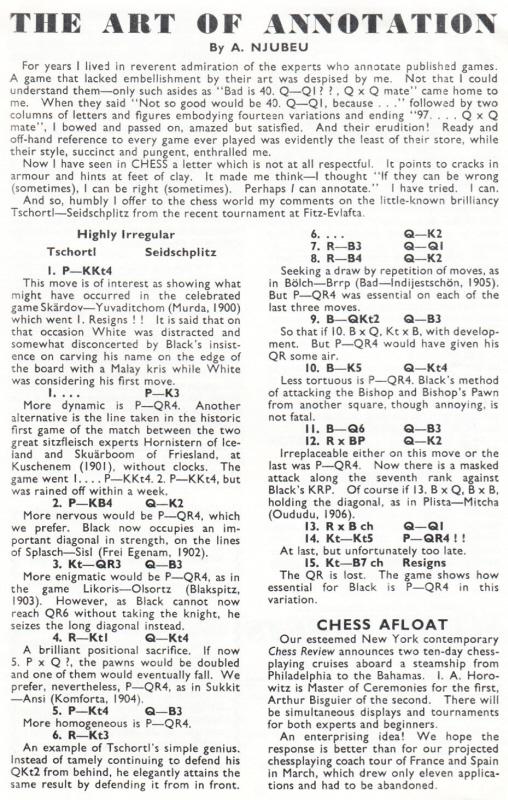
Source: CHESS, 4 August 1956, page 295.
8156. Smyslov
Another example of the quirkiness of CHESS, from page 73 of the 8 September 1956 issue:
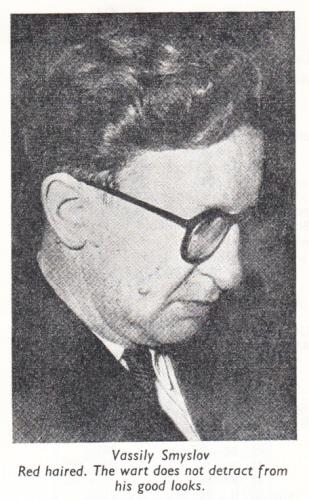
8157. The End Game (C.N. 8098)
John P. Marquand’s introductory commentary on his short story The End Game when it was anthologized on pages 144-194 of his book Thirty Years (Boston, 1954):
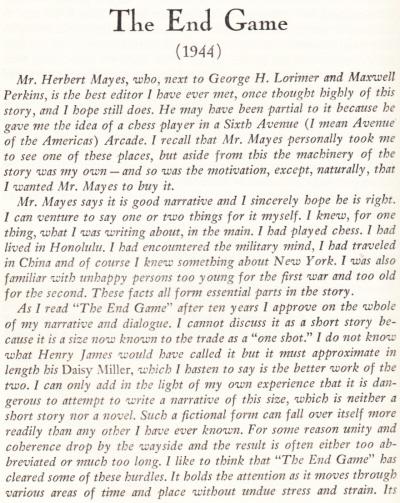

8158. More Koltanowski
From page 73 of Chessnicdotes II by G. Koltanowski (Coraopolis, 1981):
‘During the International tournament in Paris, 1927, Dr Alexander Alekhine had all of the contestants up to his hotel suite. He had just returned from Argentina, having beaten Jose Raoul Capablanca for the world title in Buenos Aires. After a special rapid transit round robin tournament, coffee, tea, whiskey, cake and “klatch”, I managed to corner our host and asked him: “Is there anyone in the world today that could take the world title away from you?” Alekhine twiddled his blond hair and smilingly replied, “Non! I am the greatest!”’
Wanted: information about ‘the International tournament in Paris, 1927’.
8159. Ortueta v Sanz (C.N. 8153)
Pointing out an article by Joaquim Travesset about this game, Christian Sánchez (Rosario, Argentina) comments:
‘The novelty is that the writer’s conclusion, that the Ortueta v Sanz game was a hoax, is based on his view of the character of one of the players.’
8160. Kottnauer
C.N. 8148 gave a loss by Čenĕk Kottnauer in a simultaneous display in Rapperswil, Switzerland on 31 January 1953. Earlier that month he won a tournament in Lucerne, and Leonard Barden (London), who was also a participant, informs us:
‘Čenĕk Kottnauer used that event to announce that he was seeking asylum in the West. He had been in the Czechoslovakian sports ministry and believed that there was an attempt by Karel Opočenský, who wanted his job, to link him to the Rudolf Slánský group. Kottnauer’s wife Danielle joined him in Lucerne after being smuggled out of Prague in the boot of a diplomatic car. Kottnauer and I became good friends, and I was still visiting him for blitz sessions 30 years later.
I gave further details at the English Chess Forum on 25 January 2009.’

Čenĕk Kottnauer (Schweizerische Schachzeitung, January 1953, page 1)
With regard to the Lucerne, 1952-53 tournament, the FatBase database ascribes to Leonard Barden a short lost against Marcel Post of Lausanne (1 e4 c5 2 Nf3 d6 3 d4 cxd4 4 Nxd4 Nf6 5 Qd3 g6 6 g3 Bg7 7 c3 Nbd7 8 Bg2 O-O 9 O-O a6 10 b3 Qc7 11 Bb2 b5 12 Nd2 Bb7 13 Rac1 Ng4 14 c4 b4 15 Qe2 Ndf6 16 Nc2 Qa5 17 a3 bxa3 18 Bc3 Qxc3 19 White resigns), but that was Kottnauer’s win against Post (played on 3 January 1953 and published in the Neue Berner Zeitung, 31 January 1953).
On 30 December 1952 Leonard Barden won against Post (1 e4 e5 2 Nf3 Nc6 3 Bb5 a6 4 Ba4 d6 5 Bxc6+ bxc6 6 d4 f6 7 c4 g6 8 Nc3 Nh6 9 dxe5 fxe5 10 Bg5 Qd7 11 Bf6 Bg7 12 Nxe5 Resigns), as recorded in his tournament report on page 90 of the February 1953 CHESS:
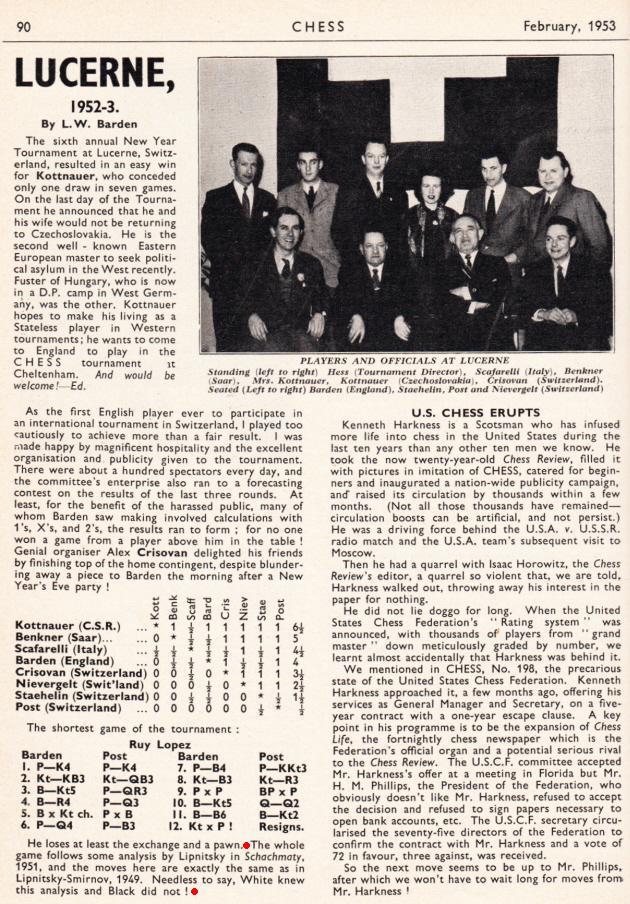
When Post annotated his defeat on page 4 of the January 1953 Schweizerische Schachzeitung he showed no awareness of the precedents highlighted above:
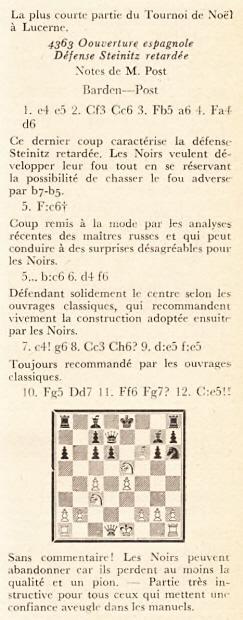
Can readers provide details regarding the Lipnitsky game and analysis?
8161. Euwe on Nottingham, 1936
From pages 289-290 of the October 1936 Deutsche Schachzeitung:


A French version was published on pages 173-174 of the Schweizerische Schachzeitung, November 1936:
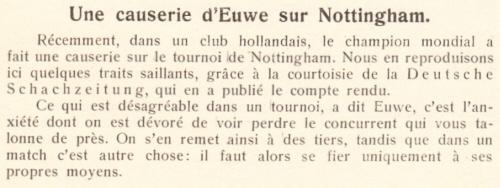
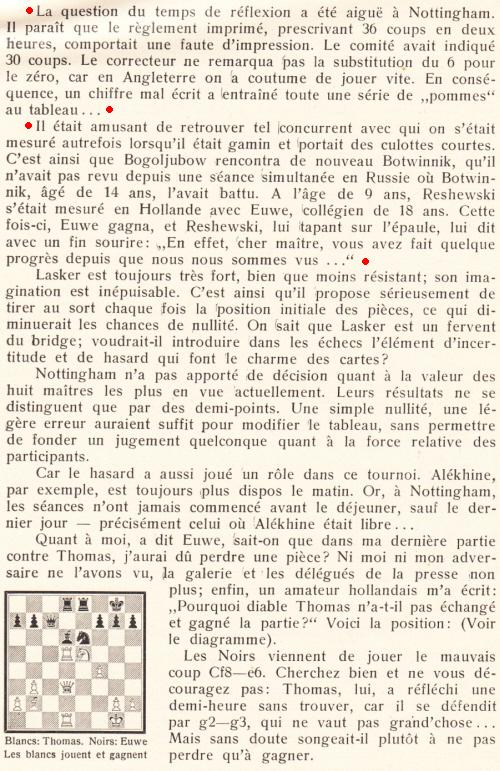
Three statements attributed to Euwe stand out:
- Bogoljubow lost a simultaneous game to Botvinnik in or around 1925;
- At the age of 18 Euwe played in a simultaneous display given by the prodigy Reshevsky;
- The time-limit at Nottingham was due to be 30 moves in two hours, but when an error (‘36’) was made in pre-tournament documentation it was considered necessary to adhere to that unintended figure.
Concerning the time-limit, a similar report appeared on page 71 of Schach-Grossturnier Nottingham 1936 by Hans Kmoch (Vienna, 1938):

We revert to the issue of the time-limit towards the end of C.N. 8162.
8162. Tartakower at Nottingham, 1936
Tartakower’s own account of the journey to Nottingham from Rotterdam, referred to by Kmoch at the end of the previous item, was given in an article on pages 330-331 of the November 1952 Chess Review:
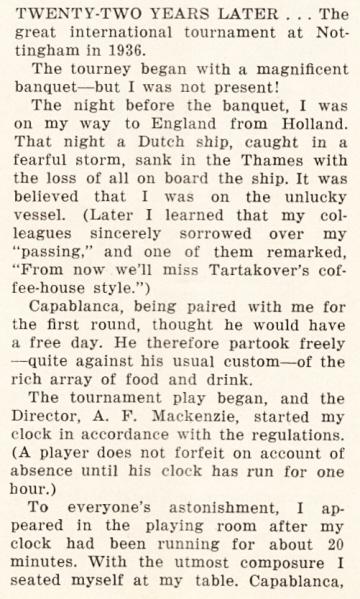
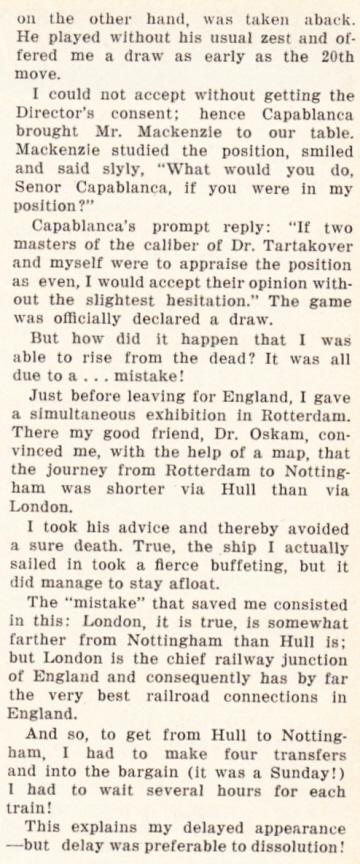
When A. Soltis availed himself of that narrative (without specifying his source, naturally) on pages 162-163 of The Great Chess Tournaments and Their Stories (Radnor, 1975) Capablanca’s phrase ‘without the slightest hesitation’ became ‘with the slightest hesitation’.
It is, though, difficult to reconcile Tartakower’s account (including its reference to ‘Sunday’) with that of W.H. Watts on page xviii of Alekhine’s book on Nottingham, 1936:
‘The Opening Ceremony took place in the main Assembly Hall of the University at noon on 10 August; there was a very large attendance, all the masters, with the exception of Capablanca, who was indisposed, being present.’
The full schedule is given below from a 16-page ‘General Information’ brochure on Nottingham, 1936:


On the subject discussed in C.N. 8161, the brochure contains no information about the time-limit. Alekhine’s tournament book (see page 1) confirms that it was indeed 36 moves in two hours, and at the bottom of the score-sheets for the event ‘two hours’ was stipulated after move 36. In the late 1980s the Manhattan Chess Club sent us photocopies of a number of Capablanca’s score-sheets, including this one:
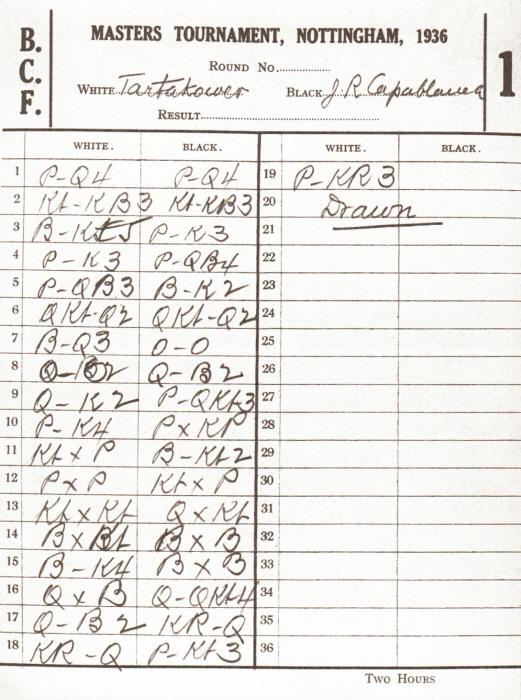
There was no reference to any special circumstances (relating to Tartakower’s late arrival) in Capablanca’s notes to this game on page 3 of the Russian Tournament Bulletin (special issue of 64), No. 2, 17 August 1936. For an English translation, see page 277 of our book on the Cuban.
8163. Tartakower on Capablanca
Further to C.N. 8162, with its reference to A. Soltis, another writer who used the Tartakower article (for its account of a conversation with Capablanca in 1938) without identifying any source was R.E. Fauber, on page 60 of Chess Digest Magazine, March 1973 and on page 165 of his book Impact of Genius (Seattle, 1992).
On page 331 of the November 1952 Chess Review Tartakower wrote concerning the Cuban:
‘On that occasion, he remarked, “I relied too much on intuition and didn’t prepare properly for my world championship match with Alekhine in 1927. I paid the penalty.”
“Thereafter I tried to avoid intuitive play as much as possible, and this cost me many a valuable point.
“So intuition was at fault?”, I inquired.
“Intuition”, Capablanca replied, “is a wonderful means to an end; but intuition should not be made the end of all the means that intelligence places at our command. This may seem like one of the paradoxes you love so dearly; but it is, just the same, a tragic truth which I have felt very deeply in the course of a career which has been rich in kaleidoscopic changes.”’
The full passage (including a reference to racehorses which was quoted in C.N. 2437 and on page 172 of A Chess Omnibus):
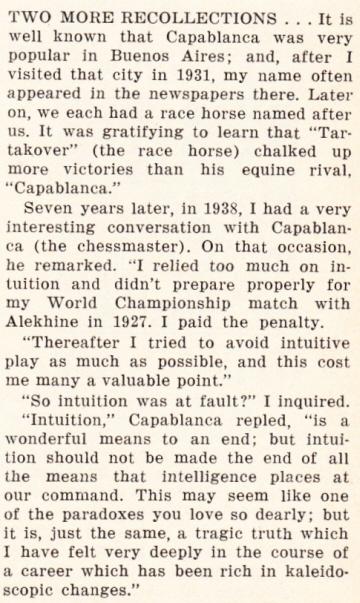
8164. Other times
From an unsigned article ‘The Impressions of a Spectator at Nottingham’ on pages 481-482 of the October 1936 BCM:
‘The only complaint I heard was that the spectators in the room in the upper hall, where the masters played, were not allowed to smoke, and this caused several people who had intended to remain four or five days to leave after one or two.’
8165. Nottingham, 1936 (audio and newsreel material)
‘The Nottingham tournament was exceptional in yet another respect. The British Broadcasting Corporation suddenly became aware of the existence of the game of chess and agreed to give broadcasts on the opening and closing days of the tournament. The chief speakers on each occasion were A.J. Mackenzie, the controller, and Alderman Derbyshire, but Dr Max Euwe, Señor Capablanca and R.H.S. Stevenson also spoke.
There were also several broadcasts direct from the University buildings to Holland by Dr Euwe and others, and because of the keen interest in the tournament shown in Russia, there was a regular telephone service with Moscow, and the controller was actually interviewed over the telephone by the “Moscow Evening News”.’
Source: pages xvii-xviii of Alekhine’s Nottingham, 1936 tournament book (in W.H. Watts’ Introduction).
On page xviii Watts discussed the closing dinner at the Victoria Hotel, Nottingham on 28 August 1936:
‘... much interest was shown in recordings of the broadcasts which were reproduced during the evening.’
Page 519 of the October 1936 BCM also referred to the closing dinner:
‘There was a pause from 8 to 8-15 while the account of the congress on the wireless news was turned on, and the gathering listened to Dr Euwe, J.R. Capablanca, J.N. Derbyshire and A.J. Mackenzie.’
From page 3 of the 14 September 1936 CHESS:
‘Several radio broadcasters were arranged at which Dr Euwe, Señor Capablanca and others spoke; one of these broadcasts was switched on in the course of the farewell banquet for prize-winners and contestants from abroad. The Radio Times visualized a running commentary on a chess congress as a possibility of the future. During the congress Dr Euwe broadcasted several times from a room in the University to all stations in Holland.’
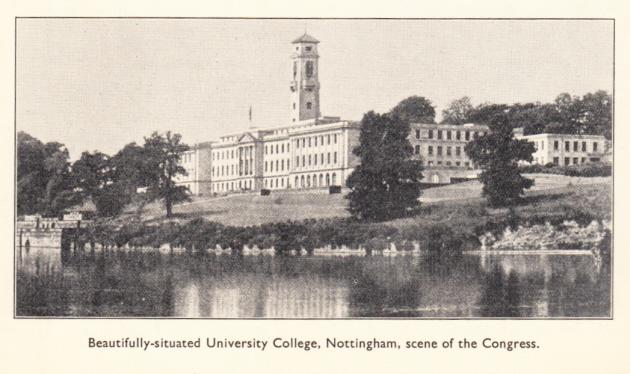
Source: CHESS, 15 September 1936, page 5
On page xix of the tournament book W.H. Watts wrote:
‘One of the news-reel men got a few shots of R.H.S. Stevenson rowing Miss Menchik on the University Lake, and the picture appeared for a week in the News item and prompted a draughtsman on a local paper to insert a couple of pen drawings which reminded one of Tom Webster’s drawings of the London, 1922 congress. The first showed R.H.S. Stevenson and Miss Menchik in their boat on the Lake, and the second drawing was similar in motif. It was an imaginary picture of Bogoljubow and Vidmar rowing on the same lake, but the boat had given up the unequal task and had sunk and left the masters sitting on the water with the oars in their hands and a surprised and apprehensive look on their faces.’
Page 8 of CHESS, 14 September 1936 reported:
‘The local news theatre sent a cameraman round to take a few films of the players. R.H.S. Stevenson rowing Miss Menchik round the ornamental lake ... featured at the “pictures” for a week.’
The magazine returned to the subject on page 49 of the 14 October 1936 issue:
‘Our account of Mr R.H.S. Stevenson’s (tournament controller) boating expedition with Miss Menchik, at Nottingham, seems to have been incorrect in one essential particular. From reliable sources we learn that it was Miss Menchik, not Mr Stevenson, who did most of the rowing.’
8166. Tartakower’s trip to Nottingham (C.N.s 8161 & 8162)
As shown in C.N. 8162, Tartakower stated on page 331 of the November 1952 Chess Review that he arrived 20 minutes late for his first-round game against Capablanca in Nottingham (10 August 1936), having travelled from Rotterdam via Hull. By choosing that route, he claimed, he had ‘avoided a sure death’, because the Dutch ship to London that he had envisaged taking ‘sank in the Thames with the loss of all on board’.
Olimpiu G. Urcan (Singapore) has examined a number of British newspapers of the time and has found reports of only one major accident on the Thames during the relevant period, i.e. on 9 August 1936. It involved Batavier IV, a Dutch steamer from Rotterdam, but the only casualty was its cargo of fruit.
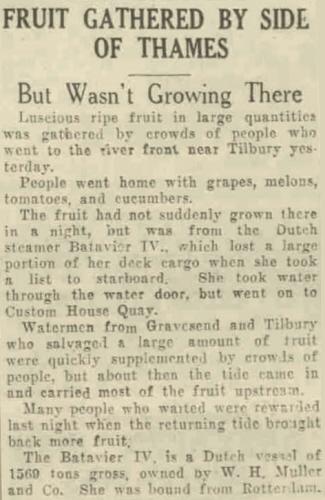
Aberdeen Journal, 10 August 1936, page 7
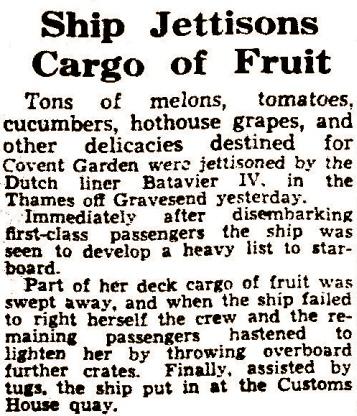
Daily Mail, 10 August 1936, page 7

Daily Mail, 11 August 1936, page 5
Mr Urcan also notes that the report on the first round of play on page 1 of the Nottingham Evening Post, 10 August 1936 does not indicate any surprising late arrival by Tartakower:

8167. Tartakower v Capablanca (C.N. 8162)
David Abrams (Syracuse, NY, USA) writes:
‘Tartakower’s account of his game with Capablanca, as quoted in Chess Review, November 1952, includes an assertion that Capablanca “offered me a draw as early as the 20th move”. Yet Capablanca’s own score-sheet ends with White’s (Tartakower’s) 19th move, followed by the word “Drawn”.
Assuming that the players followed protocol and offered draws only after their moves had been played (and recorded), it would appear from Capablanca’s score-sheet that it was Tartakower himself who offered the draw – unless Capablanca never recorded his 19th move on the score-sheet.
Are you able to clarify this matter?’
As regards the moves played, we have found no contemporary source which contradicts what Capablanca wrote on his score-sheet, i.e. that the last move of the game was Tartakower’s 19 h3.
On page 1 of Alekhine’s tournament book, the controller, A.J. Mackenzie, wrote:
‘Capablanca, who has missed the opening luncheon through slight indisposition, is not in the mood for extending himself against Tartakower and draws in 19 moves. For the first time, in England at any rate, the FIDE rule that no game shall be agreed drawn in less than 30 moves is done away with, since the rule is so easily evaded when desired.’
The book did not include the rules under which the tournament took place, but an international code had been adopted by FIDE and the British Chess Federation a few years previously. The full text is reproduced in a new feature article The Laws of Chess (1931). It will be observed from Article 16(d) on page 265 that the reference to games being drawn ‘by mutual agreement’ incorporated no restrictions as to whether the ‘Player’ or the ‘Opponent’ had to make the draw offer.
8168. Alderman
Derbyshire (C.N. 6163)
From page 78 of Reshevsky on Chess by Samuel Reshevsky (New York, 1948):
‘The great Nottingham tournament of 1936 was made possible through the generosity of Alderman Derbyshire. He sponsored the event to commemorate his winning first place in the masters’ tournament of 1886. The Alderman was one of the great patrons of chess. Many European tourneys owed their inception or their final success to his keen interest in and love for the game.’
The reference to ‘winning first place in the masters’ tournament of 1886’ is an obvious error.
Below is the obituary by D.J. Morgan published on page 191 of the June 1954 BCM:
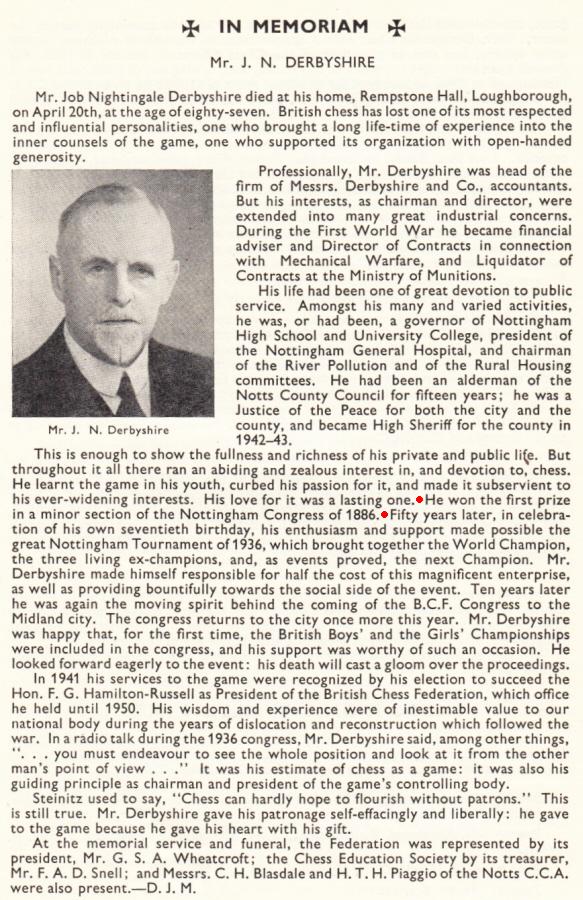
On page ix of Alekhine’s book on Nottingham, 1936 W.H. Watts wrote:
‘The tournament was intended to mark the jubilee of the Nottingham tournament of 1886, and also to commemorate Alderman Derbyshire’s victory in one of the minor events at that meeting. The handsome board and set of men which he won on that occasion were on exhibition during the tournament.’
To date, we have been unable to find information about the ‘minor event’ in question. No help is offered by, for instance, pages 360-361 of the August-September 1886 BCM or page 25 of the Chess Player’s Chronicle, August 1886:

Were there other minor events, perhaps reported in local newspapers of the time?
That year the Chess Player’s Chronicle had published two games played by Derbyshire in other competitions: 12 May 1886, pages 502-503 (a draw with Miniati in a team match) and 23 June 1886, page 549 (a loss in 17 moves to E. Marriott in a handicap tournament in which he received the odds of the queen’s knight).
8169. Margate, 1936
Many annotators of the 12th game in the 1972 world championship match (Fischer v Spassky) referred, on or around move 16, to Ståhlberg v Capablanca, Margate, 1936, although only for that earlier game’s theoretical significance.
Gideon Ståhlberg – José Raúl Capablanca
Queen’s Gambit Declined
Margate, 23 April 1936
1 d4 Nf6 2 c4 e6 3 Nc3 d5 4 Nf3 Nbd7 5 Bg5 Be7 6 e3 O-O 7 Rc1 c6 8 Bd3 h6 9 Bh4 dxc4 10 Bxc4 b5 11 Bd3 a6 12 a4 bxa4 13 Nxa4 Qa5+ 14 Nd2 Bb4 15 Nc3 c5 16 Nb3 Qb6 17 dxc5 Bxc5 18 Nxc5 Qxc5 19 Bg3 Bb7 20 O-O Rfd8
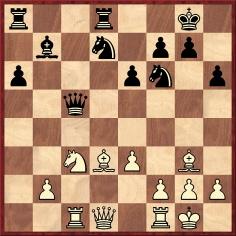
21 Nb5 Qb4 22 Nd6 Bd5 23 e4 e5 24 exd5 Qxd6 25 Rc6 Qxd5 26 Rxa6 Rab8
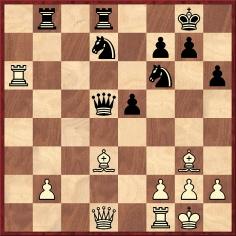
27 Rd6 Qb7 28 Bf5 Qb5 29 Re1 Rb7 30 h3 Re8 Drawn.
The game was published on pages 326-327 of CHESS, 14 May 1936 without notes but with this commentary:
‘Capablanca got into difficulties against Ståhlberg, but the latter ran short of time and decided to accept one of Capablanca’s offers to draw. Under the rule which stated that no game should be agreed drawn before 30 moves had been played by each side, the two contestants had to play on a further few moves before handing in their score-sheets. The play now became amusing, both players unconsciously relaxing; first Ståhlberg made a slip which would have lost a piece, and then Capablanca similarly made a move which allowed the possible gain of a pawn. Naturally these mistakes were not exploited since the agreement to draw had been reached. Readers may amuse themselves by looking for them.’
The game was annotated languagelessly on pages 194-195 of volume two of the ‘Chess Stars’ work on Capablanca (Sofia, 1997), and below is page 159 of the Swedish magazine Schackvärlden, June 1936:

8170. My System
All kinds of opinions, for and against, informed and uniformed, have been expressed about Nimzowitsch’s My System. It is worth noting the view of C.J.S. Purdy, a great author in his own right, on page 62 of Chess World, 1 March 1949:
‘Nimzowitsch’s immortal masterpiece. The greatest of all chess books, in the sense that it has, more than any other, really changed the methods of master players – and equally, of course, those of strong amateurs.
We all hear books described as “must” books, but this is the “must” book.’
8171. Alderman Derbyshire (C.N.s 6163 & 8168)
Olimpiu G. Urcan (Singapore) has found these cuttings:
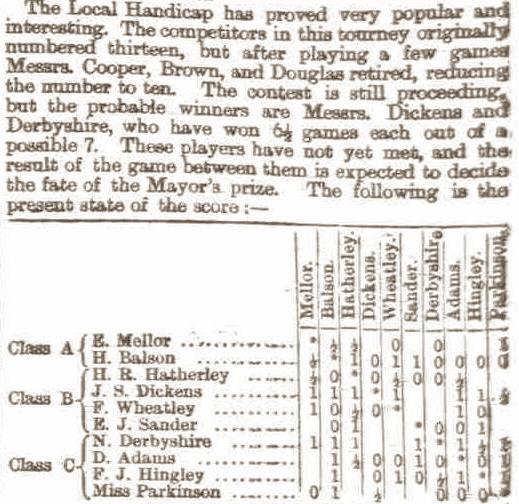
Nottinghamshire Guardian, 13 August 1886, page 3
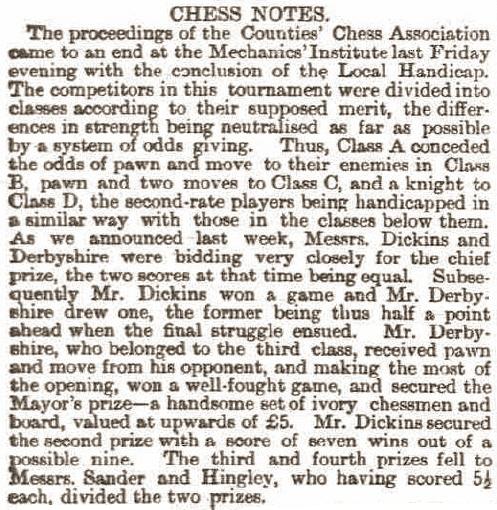
Nottinghamshire Guardian, 20 August 1886, page 4

Nottinghamshire Guardian, 3 September 1886, page 3
1 e4 e6 2 d4 c5 3 c3 Nc6 4 dxc5 g6 5 Be3 Nh6 6 Nd2 Nf7 7 Ngf3 Bg7 8 Nc4 Nce5 9 Nd6+ Nxd6 10 cxd6 O-O 11 Nxe5 Bxe5 12 Qd2 b6 13 f4 Bg7 14 e5 Bb7 15 O-O-O Qc8 16 Rg1 Bd5 17 Kb1 Qc6 18 Qc2 b5 19 g3 Rfc8 20 Bg2 Bxg2 21 Rxg2 Qb7 22 Rgd2 a5 23 Bd4 b4 24 c4 Rc6 25 g4 Qa6 26 c5 a4 27 Qd3 Qb7
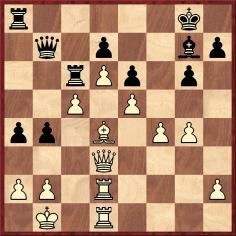
28 f5 b3 29 a3 exf5 30 gxf5 g5 31 e6 Bxd4 32 Qxd4 dxe6 33 fxe6 Rd8 34 e7 Resigns.
Our correspondent has also located on page 3 of the Nottinghamshire Guardian, 26 October 1889 a game between E. Marriott and N. Derbyshire ‘played recently at the Mechanics’ Institution’:
1 e4 e5 2 f4 exf4 3 Bc4 d5 4 Bxd5 Qh4+ 5 Kf1 Nf6 6 Nf3 Qh5 7 Nc3 c6 8 Bb3 g5 9 h4 h6 10 Kg1 g4 11 Ne1 Be7 12 d4 f3 13 e5 f2+ 14 Kxf2
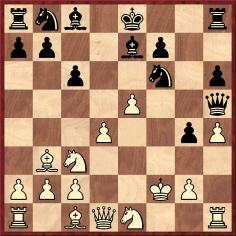
14...Ne4+ 15 Kg1 Ng3 16 Rh2 Qxe5 17 dxe5 Bc5+ 18 White resigns.
8172. Who?
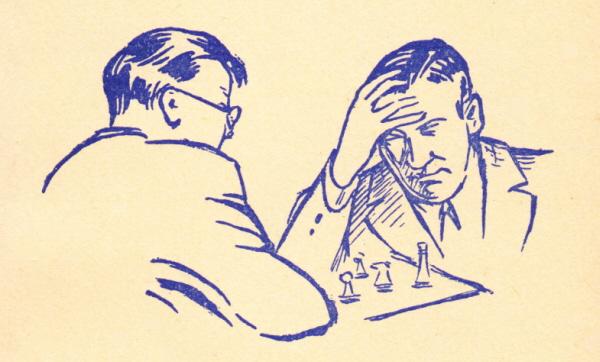
| First column | << previous | Archives [108] | next >> | Current column |
Copyright: Edward Winter. All rights reserved.
